Abstract
In the 2019 season, the joint Leiden-Turin Expedition to Saqqara continued work in the area north of the tomb of Maya with the aim of lowering the terrain above the new tomb discovered during the 2018 season (V82.1) and to prepare the area for further exploration in 2020. Many layers of deposit situated immediately to the north of the new tomb were removed and – although they mostly originated from previous excavations in the 1980s and 1990s – systematically investigated. Several dumps of organic material such as linen and wood as well as numerous small finds and relief fragments were identified and recorded. In addition, existing storage facilities on site were renovated and upgraded. In this process, part of the underground structures of the tombs of Horemheb and Meryneith were surveyed by the 3D Survey Group (Politecnico di Milano). Thanks to the cooperation with the same Milanese team, a new documentation method was tested during the ongoing excavation work. Within a 3D-model the different stages of excavation were recorded, allowing the digital reconstruction of the stratigraphy of the whole area and the documentation of all finds in their original contexts. A Digital Surface Model of the entire concession area was also produced, and 3D-models of some of the previously excavated monumental tombs were created. Lastly, since heavy rainfalls had damaged many of the earlier excavated monumental tombs open to the public, they were consolidated and where necessary rebuilt.
1. Introduction
During the 2019 season, between 16 March and 24 April, the Leiden-Turin Joint Expedition to Saqqara continued work in the northern sector of its concession area. In addition, the shaft and underground chambers of the tomb of Meryneith were surveyed. The staff consisted of Christian Greco and Lara Weiss (field directors), Paolo Del Vesco (archaeologist and deputy director), Miriam Müller (archaeologist), Daniel Soliman (epigrapher), Nico Staring (archaeologist), Corinna Rossi, Alessandro Mandelli and Luca Perfetti (surveyors), Barbara Aston and Valentina Gasperini (ceramicists), Stefanie Papenheim and Islam Taha (conservators), Nicola Dell’Aquila (photographer), Alice Salvador (illustrator), Lyla Pinch-Brock (artist), Nicholas Warner (architect), Ali Jelene Scheers (physical anthropologist), and Huw Twiston Davies (Egyptologist). The fieldwork benefited significantly from the kind collaboration of Dr Sabri Farag (General Director of Saqqara) and Dr Hany el-Tayeb (Director of Saqqara) and the supervision of Dr Aiman Gamal (Chief Inspector), Dr Samir Shaheen (Director of Foreign Missions at Saqqara) and field inspector Mr Yousri Ali Abdel Azeem. The restoration of various limestone relief blocks found during the previous seasons as well as of those uncovered during the 2019 season was carefully completed under the supervision of the Head of Restoration, Ashraf Ashour Shaaban, and Ragab Turki of the Central Magazine. The joint expedition is very grateful to Prof Dr Khaled el-Anany (Minister of State of Antiquities), to Dr Nashwa Gaber (General Director of Foreign Missions) and to the Members of the Permanent Committee of the MSA for granting permissions, advice and assistance. As always, we are grateful to the mission’s local agent Salah el-Deen Hasabalaa, the housekeepers and chefs of the Saqqara rest house, Atef Sayed Ramadan and Mahmoud Abu el Hassan Ahmed, and the more than thirty workmen,
2. Preliminary report on the excavation
(Paolo Del Vesco and Nico Staring)
The excavated area lies in the northernmost sector of the concession, immediately to the north of the well-known Eighteenth Dynasty tomb of Maya (Fig. 1). This area, which has been the focus of the mission’s fieldwork since 2017, was used by the former EES-Leiden archaeological expeditions during the late 1980s and early 1990s to dispose of sand and debris excavated from the tomb of Maya and its vicinity. As a result, a considerable spoil heap was formed. This mound of loose sand, several metres high, did not allow work to be continued on tomb V82.13, the new structure found and partly excavated in 2018. Therefore, most of the 2019 season was spent gradually removing the spoil heaps and preparing the area for exploration of the new tomb. The 2019 excavation extended over 26 grid squares (V80-82; W79-82; X79-83; Y-Z79-85, approx. 650 m2).
General plan of the excavation area at the end of the 2019 season. Drawing by Paolo Del Vesco based on orthophotos by 3D Survey Group, Politecnico di Milano/Leiden-Turin Expedition to Saqqara.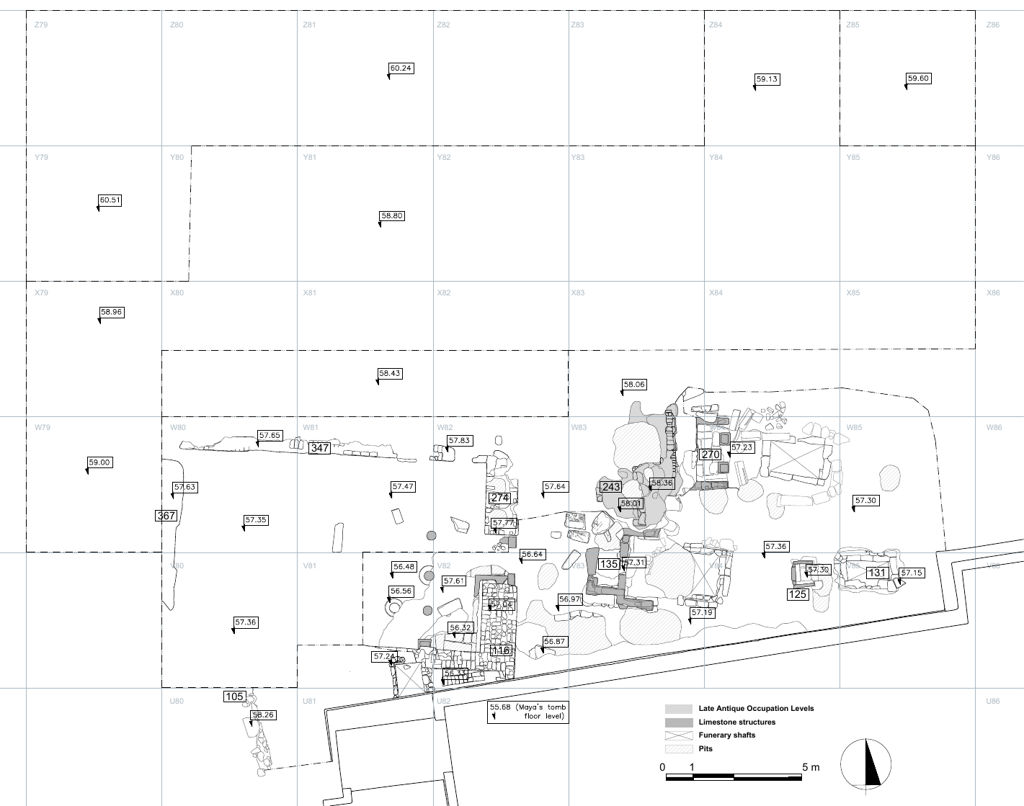
2.1 The modern spoil heaps
In order to better understand the formation of the high spoil heaps and relate it to the stratigraphic sequence recorded previously in the area stretching along the outer wall of the tomb of Maya, the decision was made to excavate the artificial mound as systematically and carefully as the timeframe of the fieldwork season allowed. A mixed system of regular arbitrary cuts, creating steps progressively sloping southward, and individual context recording was deemed to be the most cost- and time-effective approach. A number of horizontal terraces were gradually created, lowering the mound to the level of the highest preserved remains of the new tomb, at an average elevation of about 57.70 m ASL in squares W80-82. The highest part of the mound (60.90 m
The upper deposits consisted of loose sand, mixed with conspicuous quantities of potsherds, bones, small to medium-sized limestone chips, fragments of mud-bricks, and modern materials, including pieces of rope and fabric, stamped red bricks, newspaper scraps, plastic packaging, and cigarette packets. Cigarettes (Figs. 2a-b) and newspapers, in particular, could be used to date the formation of the deposits. Thanks to them we were able, for instance, to assign the first arbitrary layer of 30-40 cm (immediately beneath the topsoil) to a timespan ranging between 1988 and 1994. Within this first artificial step, two well delimited contexts (321 and 323, Fig. 3) were identified and recorded in square Z85: they included concentrations of ancient materials (palm ribs, textile fragments, bone fragments, and pieces of painted wood coffins) mixed with fragments of plastic bags and palm leaf baskets. These contexts are clearly modern dumps of specific materials, most likely from the excavation of funerary deposits in the subterranean complex of the tomb of Maya, where the former EES-Leiden archaeological mission worked in 1988 (6 January–23 March).4 The large, mostly sandy deposits of the first artificial layer within which the two dumps were found yielded numerous other objects, including Late Period shabti fragments and faience amulets, slipper-coffin pieces, and chips of relief-decorated limestone blocks.
Specimens of Cleopatra cigarette boxes associated with deposits of the 1980s. Photo by Paolo Del Vesco/Leiden-Turin Expedition to Saqqara.
Context 321: a modern dump consisting of a concentration of palm ribs, textile fragments, bone fragments, and pieces of painted wood. Photo by Paolo Del Vesco/Leiden-Turin Expedition to Saqqara.
In squares Y82-83 – at an elevation of 59.9 m ASL – newspaper scraps from 1987 were found (Fig. 4), suggesting that the associated deposits were formed during the corresponding fieldwork season of the EES-Leiden mission. This mission worked between 6 January and 16 March of that year in an area north of the tomb of Ramose in order to locate the aperture of the tomb shaft of Maya. During that season, most of Maya’s tomb superstructure was unearthed, and this might explain the larger quantity of limestone and mud-brick fragments encountered at this level of the dump deposits. Carrying on the cutting of the arbitrary steps on the mound slope towards the south, in square Y84 (context 324) a newspaper scrap from 1986 was found. In that year (from 8 January to mid-March), the EES-Leiden mission excavated three tombs, investigating both their superstructures and their subterranean burial chambers: those of Khay, Pabes, and Ramose.5 In these very loose deposits of sand and limestone flakes, a reed basket, comparable to those used by the workforce of the mission at the time, and another well delimited dump of funerary material were found. The modern dump pit included palm ribs and leaves, reed stems – some of which were still bound together by a rope and interwoven with palm leaves – textile fragments (incl. burnt ones), bones, Dutch-language newspaper scraps, pieces of plastered wood, a few potsherds, and some cotton wool. Although the main dumping area during the 1986 season lay west of the tomb of Ramose,6 it is possible that part of the excavation debris was also carried further away to the north of that area, which was to be dug the following season in search of the superstructure of the tomb of Maya.
A newspaper scrap dated to 26 January 1987, corresponding to the 1987 fieldwork season of the EES-Leiden mission. Photo by Nicola Dell’Aquila/Leiden-Turin Expedition to Saqqara.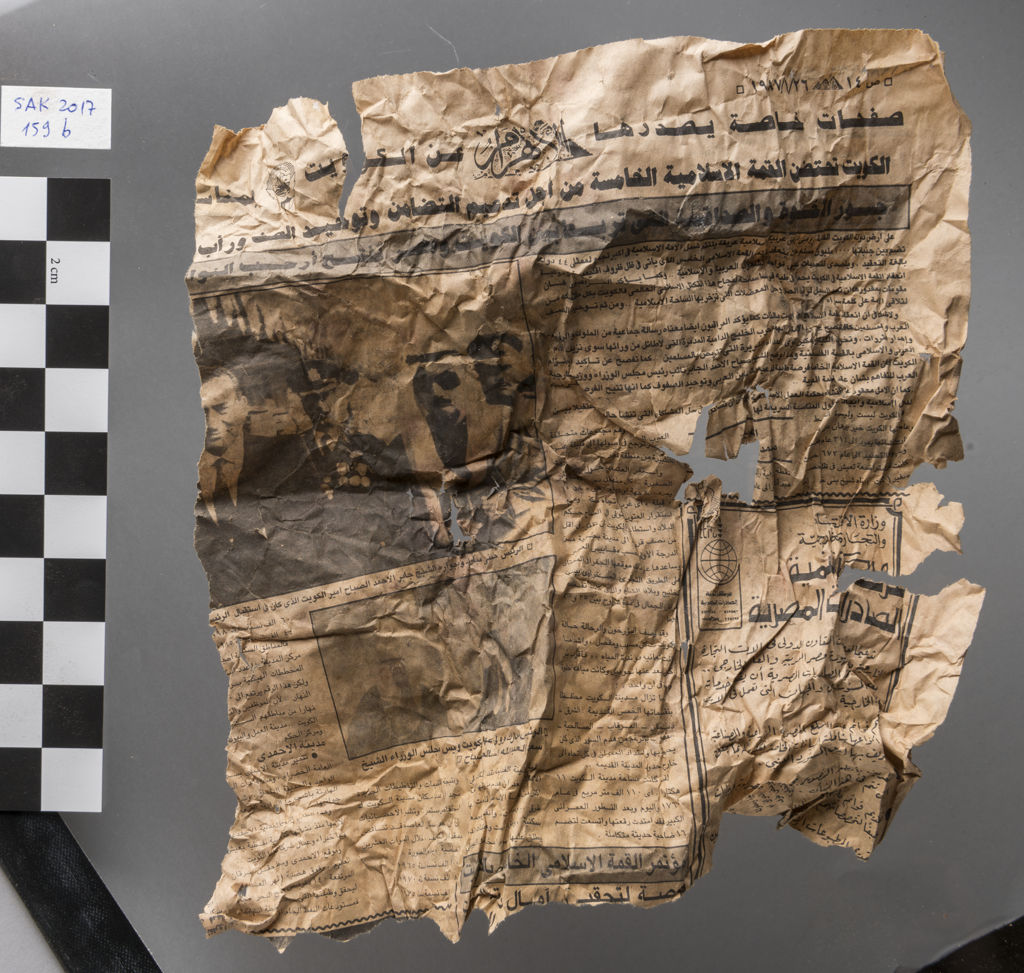
As became evident from the stratigraphic sequence visible in the east section of square Z85, the loose deposits encountered during the cutting of the higher artificial steps had gradually built up on top of a very compact mud surface (context 325), which is probably the topmost level of a mound of debris which already existed in the 1980s and is possibly visible in one of the plates of the final publication of the tomb of Ramose (Figs. 5a-b).
a: The tomb of Ramose, general view looking north, in 1987. In the background, the area currently under excavation. Photo by Rijksmuseum van Oudheden, Leiden; b: The same area, from a similar point of view, during excavation in 2019. Photo by Paolo Del Vesco/Leiden-Turin Expedition to Saqqara.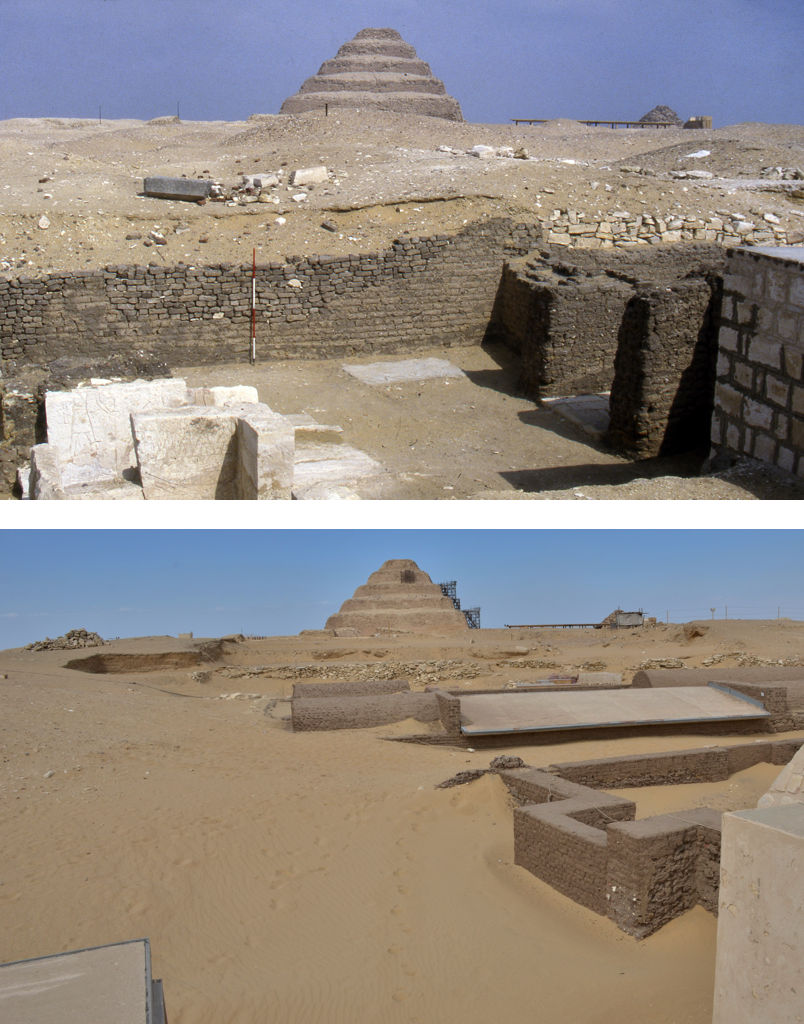
A second small mound (context 341), made of sand mixed with small limestone flakes and covered by a thick compacted surface sloping down from a maximum elevation of 59.60 m to a minimum of 58.90 m ASL, was identified in square X82. The absence of fragments of plastic bags and objects from the deposits sealed by the compact surface of these low mounds suggests that they belong among the humps that still characterise the landscape of Saqqara today. Such mounds were formed by indiscriminate ransacking of the necropolis, especially during the nineteenth century. The complex overlapping of these deposits and those deriving from more recent archaeological research has significantly altered the ancient funerary landscape and calls for more careful evaluations of the impact that present-day activities (such as archaeology and tourism) have on these often very vulnerable ancient sites. One way
2.2 A New Kingdom tomb north of Maya
In the 2018 fieldwork season, the remains of the entrance pylon of a new tomb, provisionally numbered V82.1, had been found north of the tomb of Maya.7 During the current season, after gradual lowering of the loose deposits north of the tomb, we removed the dry-stone retaining wall which we had built in 2017 and extended in 2018. The upper part of the north mud-brick wall (context 347) of the new tomb, running east-west almost exactly along the edge of the W80-82 squares and preserved up to an elevation of 57.83 m ASL, could thus be exposed for its whole length of about 11.60 m. A loose sand deposit covered the top of this wall in square W80 (context 345), which contained mud-bricks (average dimensions: 26 x 14 x 8 cm) and small flakes of limestone. Under it, a sequence of thin layers of sand, with limestone dust alternating with darker layers of sand mixed with mud-brick particles, was identified; it sloped down towards the south, right into what should have been the tomb courtyard. These layers very likely constitute the filling of one of the numerous large looting pits that were dug in this area during the nineteenth century. One should not forget that the centre of the courtyard of the new tomb lies less than 10 m away from the innermost porticoed courtyard of the tomb of Maya, which had already attracted a great deal of attention from antiquity-seekers before Lepsius partially cleared it in 1843.8 The dispersal, over an area of 3 x 2.3 m, of limestone blocks mixed with mud-bricks (complete specimens measuring 26.5 x 13 x 7 cm), and pottery sherds in square V80 (context 348, ca. 57.95 m ASL, Fig. 6) almost certainly originated from one of these looting activities. One of the limestone fragments is inscribed on two sides, one of which mentions the god Re-Horakhty (find no. R66). Among the other objects recovered from this context, four fragments of a stone canopic jar (find no. F387) stand out.
View of the dispersed limestone fragments, mud-bricks and pottery sherds (context 348) from the south. Photo by Paolo Del Vesco/Leiden-Turin Expedition to Saqqara.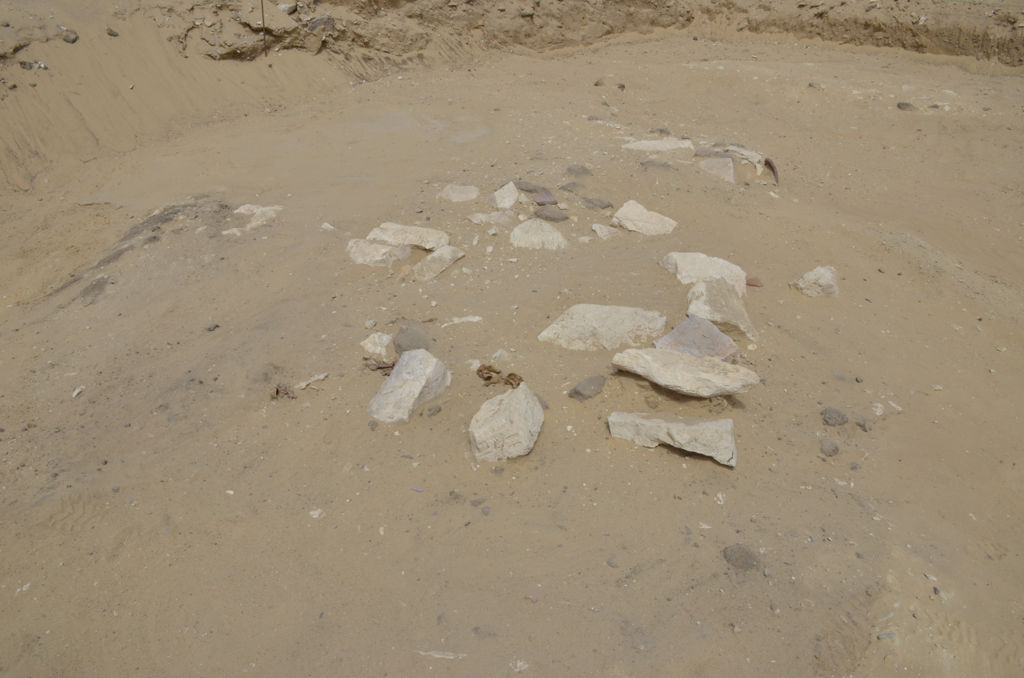
Under a somewhat compact deposit of wind-blown
A compact deposit of wind-blown sand (context 353) covers the west wall of the new tomb. Photo by Nico Staring/Leiden-Turin Expedition to Saqqara.
Test trench in the southeast quadrant of the new tomb, looking north. Photo by Paolo Del Vesco/Leiden-Turin Expedition to Saqqara.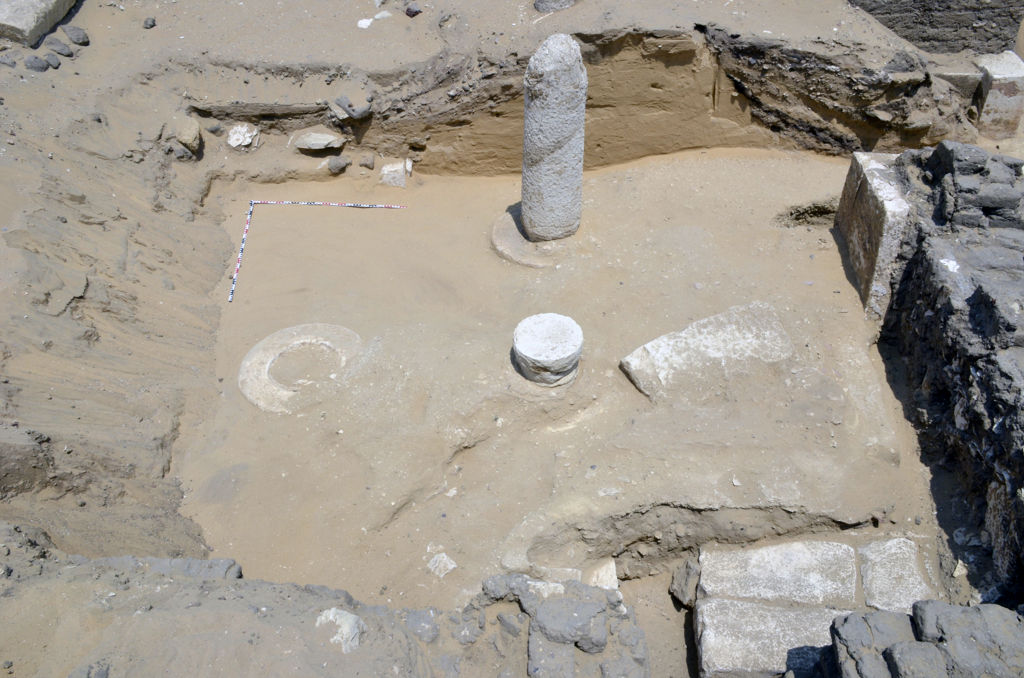
Test trench in the southeast quadrant of the new tomb, looking east, showing the position of three column bases (two with remains of columns) and one pilaster base jutting out of the south wall. Photo by Paolo Del Vesco/Leiden-Turin Expedition to Saqqara.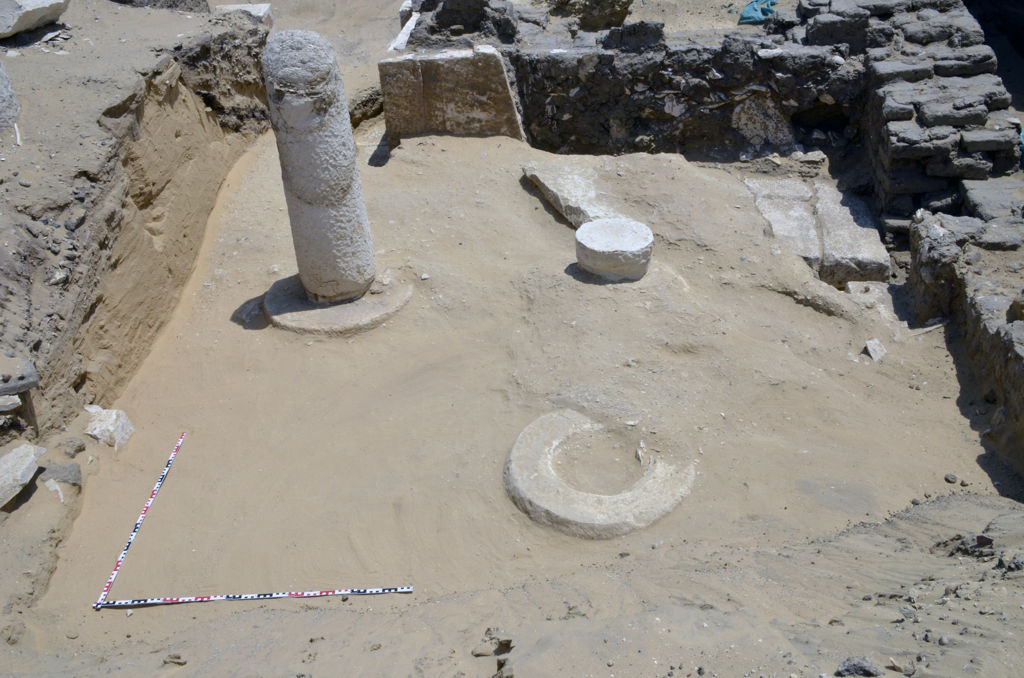
The position of the pilaster base against the south wall of the new tomb, looking west. Photo by Paolo Del Vesco/Leiden-Turin Expedition to Saqqara.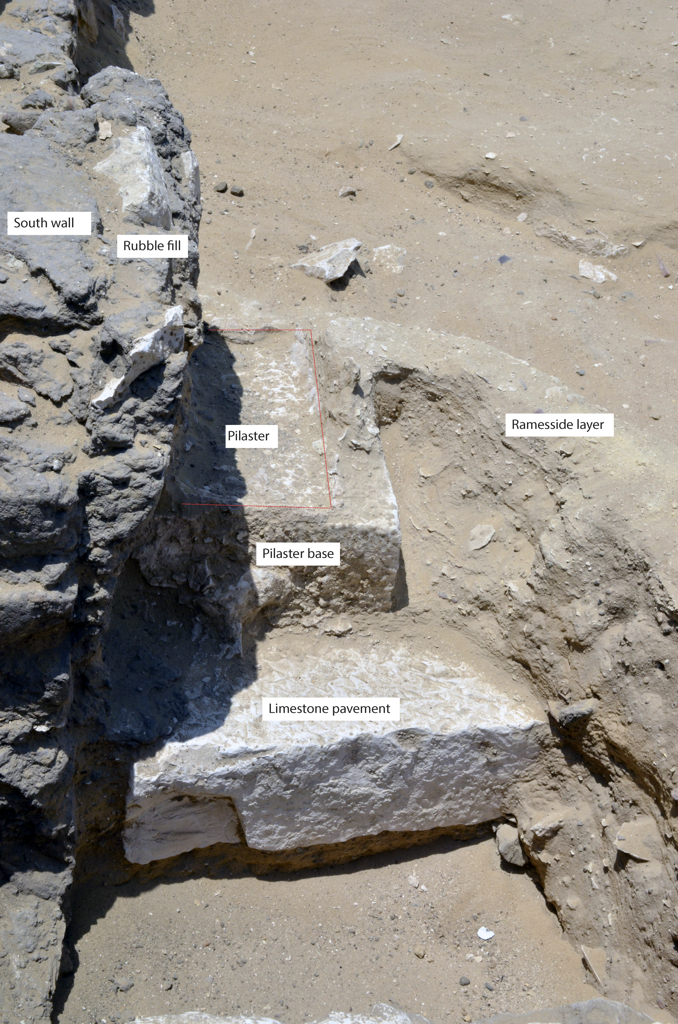
Unfortunately, preliminary investigation revealed no decorated limestone slabs still in situ along the tomb walls, at least in this area, which showed clear traces of looting, probably by nineteenth-century diggers.
One of the most exciting insights gained from the excavation of the test trench was the identification of the same thick layer of rubble, marl and pottery sherds that had been found during the previous seasons in the area surrounding the tomb and which seemingly constituted the walking level of this part of the necropolis during the Ramesside period (Fig. 11). This may suggest that the tomb was still accessible and used somehow, although already partly ruined, when the later Ramesside chapels unearthed in the 2017 and 2018 seasons were built and used. Finally, the looting pits dug along the walls in order to extract the decorated limestone slabs conveniently offered the opportunity to see, under this supposedly Ramesside layer, the original floor of the tomb, and to ascertain that the floor is
The entrance doorway to the new tomb, looking west. A thick layer of rubble, marl and pottery sherds of the Ramesside period connects the exterior surface of the tomb with the interior, where it partly covers the column bases of the porticoed court. Photo by Paolo Del Vesco/Leiden-Turin Expedition to Saqqara.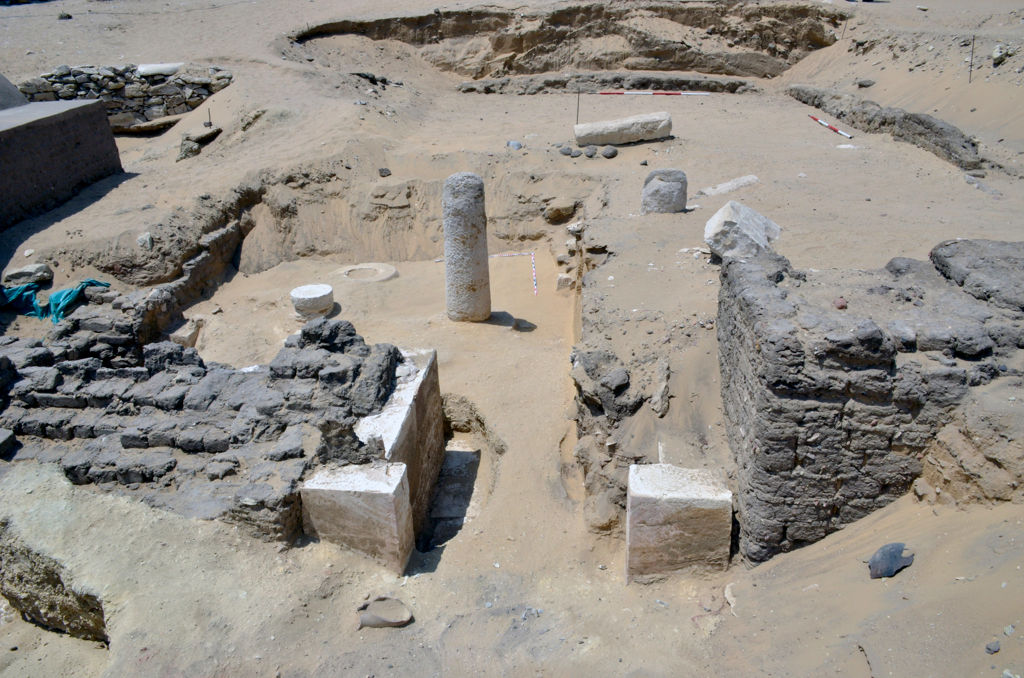
3. Brief report on the work of the 3D Survey Group of the Politecnico di Milano
(Alessandro Mandelli and Corinna Rossi)
In 2018, the Leiden-Turin Expedition to Saqqara, in collaboration with the Politecnico di Milano, started using digital imaging to document both the site and the excavation activities being carried out at it.9 In 2019, the survey team carried on the two lines of work and research that had been started in 2018: the 3D survey and modelling of the ongoing excavation, on the one hand, and that of the “completed” part of the concession, that is, the already excavated tombs and their immediate surroundings, on the other.10 These two lines of work merged into a third one, namely, the construction of an overall model of the entire concession.
3.1 Surveying and modelling the ongoing excavation and the concession area
In recording the ongoing excavation, both the method and the workflow were improved on the basis of experience gained during the previous season. During the post-fieldwork processing of the data, it had become clear that overall surveys of the entire area under excavation were particularly useful, both to record the changing ground morphology and to correctly identify the position of all the smaller contexts, which needed to be surveyed repeatedly as they were gradually dismantled. For this reason, during the 2019 season, the team regularly performed two general surveys every week, on Mondays and Thursdays.
The daily excavation work was recorded in 3D as the operations unravelled. Every morning the operators set up their topographic instruments in order to link all the ensuing surveys to the same reference system. The accuracy of topographic measurements was always kept below 1 cm. A Canon 5D Mark III camera, with alternating Canon 20-mm and SIGMA
Orthophoto of the current excavation area, at the northern limit of the Leiden-Turin Expedition concession area. Image by 3D Survey Group, Politecnico di Milano/Leiden-Turin Expedition to Saqqara.
As regards work on the already excavated tombs, the survey team performed a 3D survey of the subterranean portion of the tomb of Meryneith (see below), which is therefore the first tomb of the concession to be fully documented in 3D both above and below ground. The survey of the first section of the subterranean portion of the tomb of Horemheb was also started, and will be continued during the next season.
The overall survey of the entire concession was completed with a series of images acquired with the same camera, using the SIGMA 8-mm fisheye lens. The result of the photogrammetric process is a Digital Surface Model (DSM) that describes the different elevations of the ground.11 During the post-processing of the data, the DSM was enriched with high-resolution dense clouds of the tombs of Maya, Tia, Horemheb, and Meryneith (Fig. 13).
Digital Surface Model of the whole concession area of the Leiden-Turin Expedition to Saqqara. Image by 3D Survey Group, Politecnico di Milano/Leiden-Turin Expedition to Saqqara.
3.2 Three-dimensional survey of the underground structures of the tomb of Meryneith
(Luca Perfetti)
The underground portion of the tomb of Meryneith was 3D surveyed by means of the time-tested method of using fisheye lenses.12 The data for the vertical shaft were acquired by lowering the camera using the same method already adopted in 2018 in another shaft.13 The ensuing 3D model (Fig. 14) has an accuracy of ~1 cm. It was later georeferenced and merged with the 3D survey of the upper part of the
View 3D model 3D Model of the tomb of Meryneith and its underground complex, by 3D Survey Group, Politecnico di Milano/Leiden-Turin Expedition to Saqqara.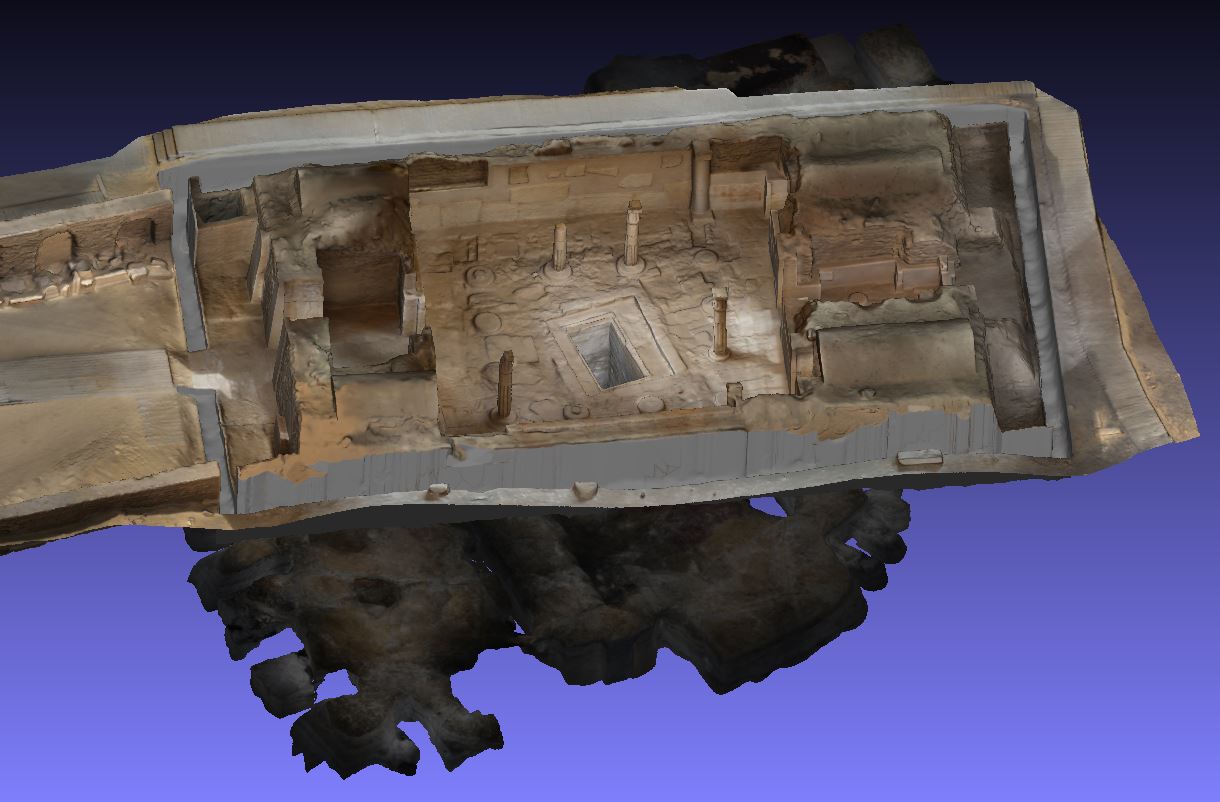
Fig. 14
Once the reliability of the survey data had been ascertained, the team moved on to test the acquisition of the same spatial data by means of videogrammetry. As part of his PhD thesis,14 Luca Perfetti carried out a series of experiments using six different geometric configurations of a multi-camera system used to acquire and compare the same 3D data. The multi-camera system is made up of four low-cost action cameras mounted rigidly on an aluminium frame; different configurations were tested in the field (Fig. 15). The device is hand-held and acquires a continuous video sequence while the operator walks along the passages and rooms to be surveyed. Spaced still frames can be later sampled from the video streams and used to achieve the video-based 3D model of the area.
The main advantages of this method are affordability and speed: the survey of the entire subterranean tomb was completed in 30 minutes. These tests were carried out within a broader frame of activities aimed at defining the best geometric hardware configuration to record tunnel-like environments. The preliminary results suggest that, in comparison with the photogrammetric survey achieved by a fisheye lens, the videogrammetric method shows a maximum deviation in the range of ~40 cm, as well as a lack of data in some areas (Fig. 16). These tests proved to be extremely useful in establishing how to develop this method into a reliable survey technique.
Examples of four different configurations for the multi-camera acquisition system used in the test. 3D Survey Group, Politecnico di Milano/Leiden-Turin Expedition to Saqqara.
Results of the videogrammetric survey of the underground portion of the tomb of Meryneith: acquisition of survey data on site (left), oriented image network (centre) and a comparison of deviation against ground-truth data (right). 3D Survey Group, Politecnico di Milano/Leiden-Turin Expedition to Saqqara.
4. Recording graffiti in the tomb of Horemheb
(Nico Staring and Luca Perfetti)
4.1 Recording tomb graffiti
The tomb of Horemheb, the general who became king in the late Eighteenth Dynasty, dominates the necropolis in the Leiden-Turin concession area. The monumental, temple-like tomb superstructure was rediscovered in 197515 and the archaeological investigation of the forecourt was concluded in 2006.16 The structure proved to contain numerous graffiti scratched into or painted onto the walls and paving stones in ancient times. Martin17 published a corpus of 34 graffiti and Raven and van Walsem18 added to it with another 10 specimens scratched into
Recent developments in the domain of digital imaging (e.g. Reflectance Transformation Imaging) have proved to offer great advantages in the documentation of graffiti.20 The 3D documentation techniques employed at Saqqara by the 3D Survey Group of the Politecnico di Milano could also offer a solution to the problem of graffiti-documentation. The Leiden-Turin expedition therefore started to experiment with the documentation of graffiti in the pylon gateway of Horemheb (Fig. 17). The integrated approach we adopted allows the graffiti to be studied in the built context and in relation to the other graffiti nearby. It also paves the way for a material approach to the study of the graffiti, in the sense that their detailed recording reveals something about how they were produced. Finally, the documentation offers the possibility of producing digital facsimile drawings by importing the orthorectified image in Adobe Illustrator as a JPG file. The following should be regarded as a progress report on a method still in the making.21 The proposed integrated approach to the study of graffiti takes into consideration the architectural and iconographic setting, the archaeological context, and the wider landscape in which the tomb structures are embedded.
The entrance doorway in the tomb of Horemheb, looking west. The arrow indicates the location of the graffiti survey on the exterior of the pylon gateway. Image by Nico Staring/Leiden-Turin Expedition to Saqqara.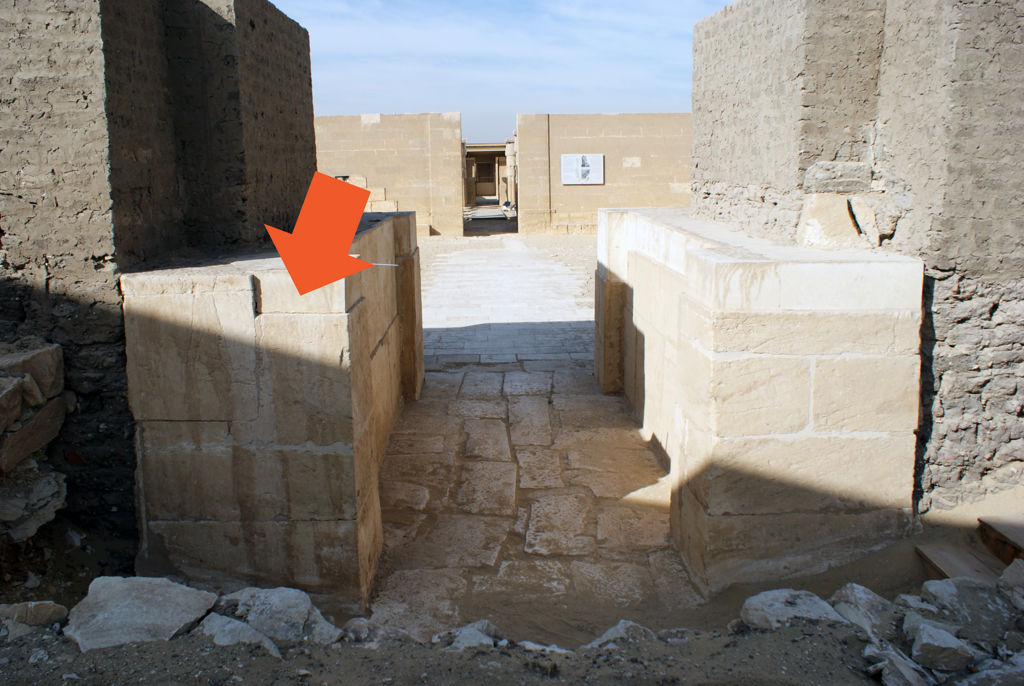
4.2 Horemheb’s entrance gateway: date of construction
In total, 25 graffiti were recorded on the stone surfaces of the pylon gateway, a mud-brick structure with a limestone-lined doorway and a limestone-block floor. The mud-brick pylon gateway is part of the tomb’s forecourt. This architectural feature was created after the construction of the tomb’s core (here considered as construction phase 1), consisting of
4.3 Horemheb’s entrance gateway: the archaeological context
The published archaeological report states that the west half of the entrance gateway was filled with windblown sand up to 1 m above floor level.24 The lower 30 cm of this sand deposit contained potsherds of Ramesside date. Thus, this part of the gateway was likely clear of sand to floor level well into the Nineteenth Dynasty. This suggests that the entrance gateway remained accessible despite increasing accumulation outside the tomb. In the east half of the gateway, the 10 cm thick deposit on top of the pavement flagstones consisted of a grey layer filled with small limestone chips and small weathered potsherds. The latter ranged in date from the early Eighteenth Dynasty to the Ramesside period. This fill likely slid into the gateway from the east. This is corroborated by the observation that in front of the gateway, to the east, a 10 cm thick mud layer sloped up away from the doorway to the north and east. Underneath this deposit, situated east of the north and south doorjambs at floor level, late Eighteenth Dynasty potsherds were found.
Orthomosaic of the southeast jamb of the pylon gateway. Image by Luca Perfetti and Nico Staring/Leiden-Turin Expedition to Saqqara.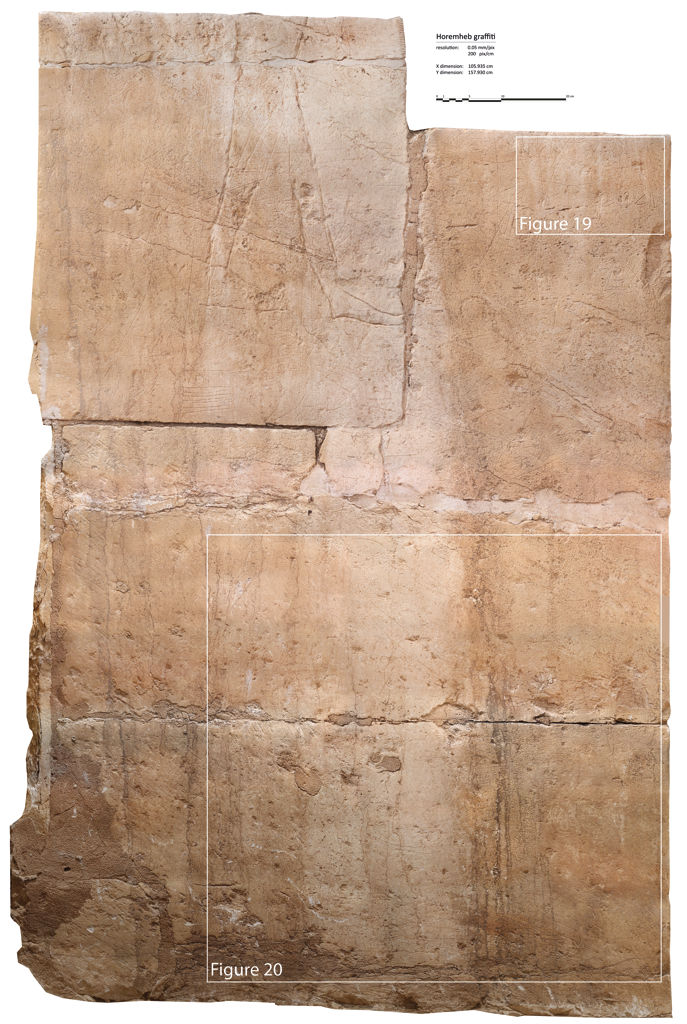
Graffito of a striding king (Gr. 36) and hieratic visitor’s inscription (Gr. 37). Orthoimage by Luca Perfetti/Leiden-Turin Expedition to Saqqara. Line drawing by Nico Staring/Leiden-Turin Expedition to Saqqara.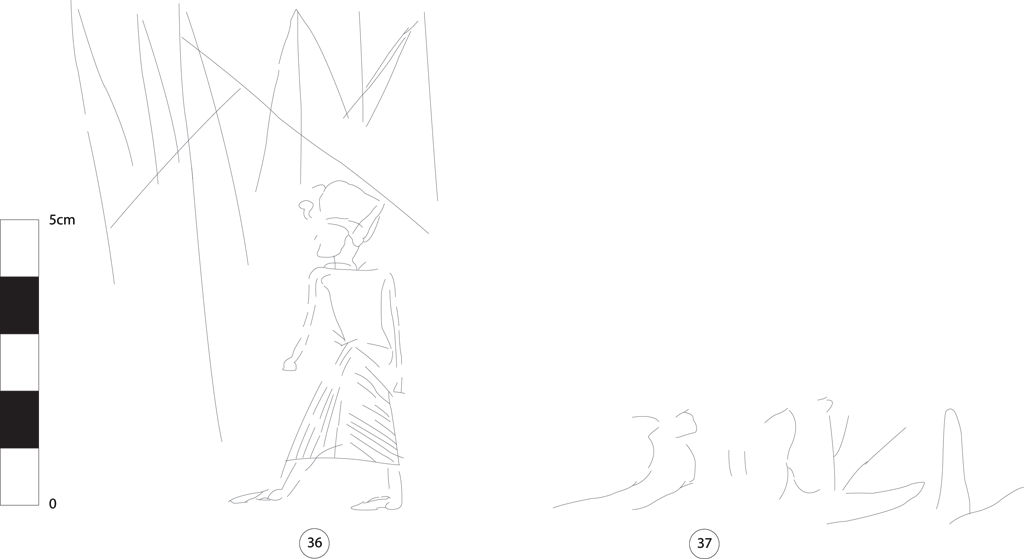
Group of boat graffiti (nos. 46-51). Orthoimage by Luca Perfetti/Leiden-Turin Expedition to Saqqara. Line drawing by Nico Staring/Leiden-Turin Expedition to Saqqara.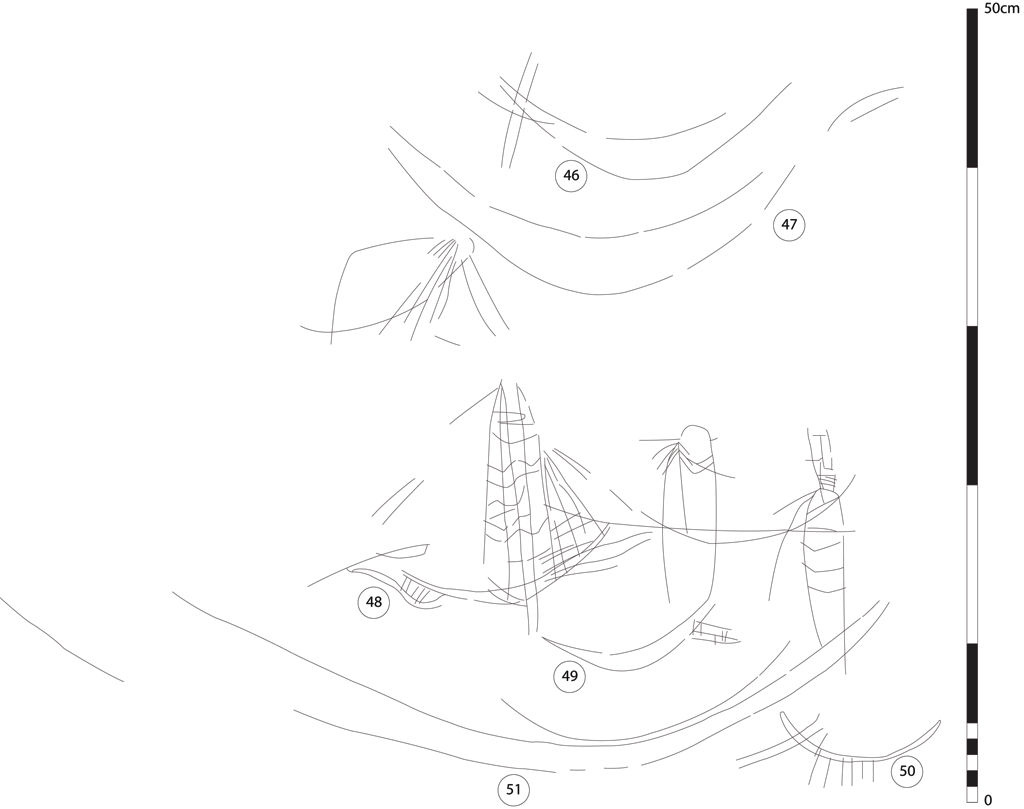
4.4 The 3D survey
The 3D survey of the graffiti of the tomb of Horemheb was designed to fulfil a twofold purpose: i) to produce an orthomosaic of the wall carrying the graffiti, and ii) to construct a high-resolution 3D model of the stone surface with the aim of enhancing the engravings by means of simulated light. The first goal required control over light conditions and a 2D image resolution of 0.5 mm/pixel; the second goal, instead, required a 3D resolution of 0.5 mm, which commonly translates to a required 2D image resolution of 0.1 mm/pixel. To meet both requirements at the same time, a full-frame 24-megapixel camera (Canon 5D Mark III) equipped with a 35 mm lens was employed. The capturing distance was set equal to the minimum focusing distance of the lens so as to ensure the maximum possible resolution with the available instrumentation. The Ground Sampling Distance (GSD) of this configuration was 0.1 mm/pixel. A white cloth was placed in front of the graffiti to diffuse the natural sunlight when present and two speed lights were employed to illuminate the scene with a narrow-incidence angle to reveal the shallow engraving. The acquisition followed classical nadiral capturing geometry and was carried out row-wise from top to bottom. The overlap between consecutive images and rows was set respectively to 80% and 60%. The acquisition ended with few additional images acquired from a distance, thus with a higher GSD, and tilted vertically to help further processing steps (structure from motion). In total, 404 photos were taken of the exterior wall surface (the limestone doorjambs) and 131 of the interior limestone doorjambs. These photos were processed at full resolution following a typical photogrammetric pipeline using Agisoft Metashape (Fig. 21). The two acquisitions were scaled using calibrated scale bars included in the data capture and the resulting scaling error was 0.003 mm.
The texturised OBJ models can be opened in the free and open-source processing software system MeshLab. The software offers the user a tool that simulates artificial light. The tool can illuminate the 3D object from different angles in a way similar to an RTI (Reflectance Transformation Imaging) application (Fig. 22).
OBJ model of the northeast doorjamb of the pylon gateway, showing the position of the photographs. Luca Perfetti/Leiden-Turin Expedition to Saqqara.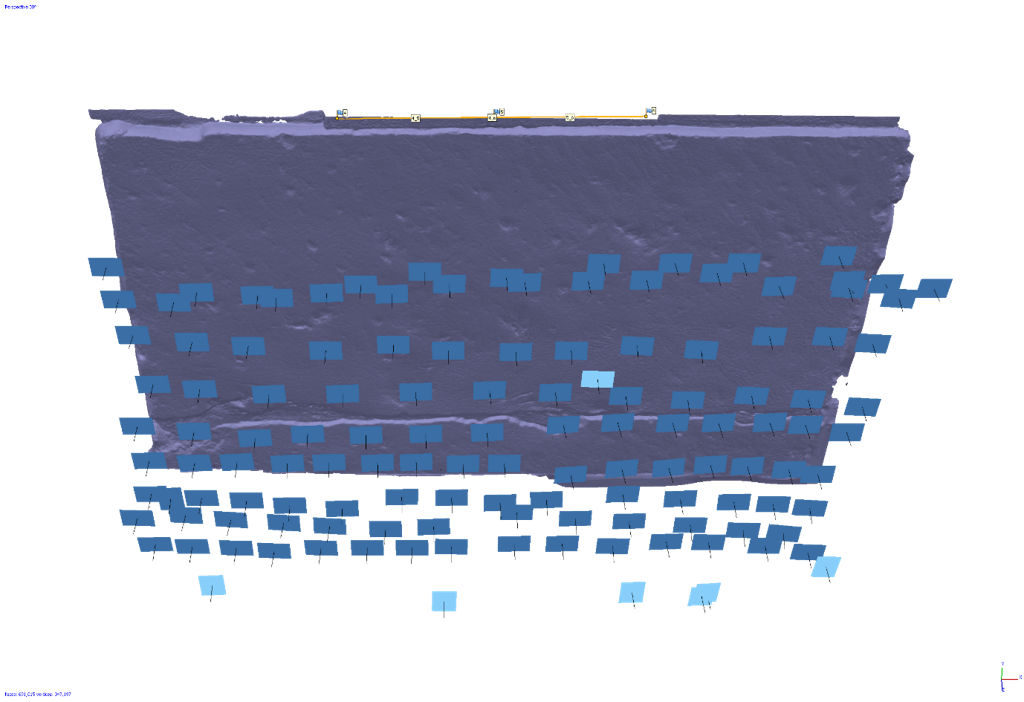
Texturised OBJ model of a section of the northwest doorjamb of Horemheb’s entrance gateway opened in MeshLab, showing the wall surface under different simulated lights. The wall section includes graffito no. 44, a king’s head, on the right-hand side of the images. Luca Perfetti/Leiden-Turin Expedition to Saqqara.
4.5 Preliminary conclusion
The graffiti carved on the exterior wall surface, in particular those on the southeast doorjamb, cover
5. Preliminary report on pottery
(Valentina Gasperini and Alice Salvador)
The ceramic analysis of the 2019 season focused on the materials from the “embalmers’ caches” (from the 2017/2018 season), shaft 131 (from the 2018 season), and the newly excavated spoil heaps of the 1980s excavations.
5.1 The “embalmers’ caches”
The excavation of the “embalmers’ caches”, begun in 2017, was completed during the 2018 season. The study of the ceramics from these seasons had not been finished in the spring of 2018,25 and its completion was hence the first task for 2019. During the first week of the 2019 season, the reconstruction and processing of the “goldfish” bowls and pot-stands were completed. In the second week, they were classified, inventoried, described, drawn, and photographed. The processing of the bottle types began in the third week. The results of the 2019 analysis confirmed the preliminary conclusions regarding the materials and forms found and processed in 2018: the newly studied pottery consisted of “goldfish” bowls, pot-stands, and bottles exhibiting the same features and characteristics as the types already studied during the previous campaigns, and no new forms were identified.
5.1.1 “Goldfish” bowls
This very standardised form usually has a diameter between 14 to 16 cm, an inturned rim that thickens slightly towards its external edge, a convex wall, and a rounded, sometimes slightly pointed base. The poor manufacturing of some of the examples may result in quite an irregular and asymmetrical shape, in particular towards the base and rim. The surface treatment is characterised by a burnished red slip, and the fabric is usually quite fine J1 (Nile silt). Only one example (Fig. 23) yielded a charcoal docket, possibly mentioning one of the four Sons of Horus. As stressed in the 2018 report, the charcoal dockets were most probably written with black ink, resulting in a very faded, and often barely legible, inscription.26 The study of the legible inscriptions, found to date on seven bowls, is ongoing.
“Goldfish” bowl C1184 with “charcoal docket”. Photo by Nicola Dell’Aquila/Leiden-Turin Expedition to Saqqara.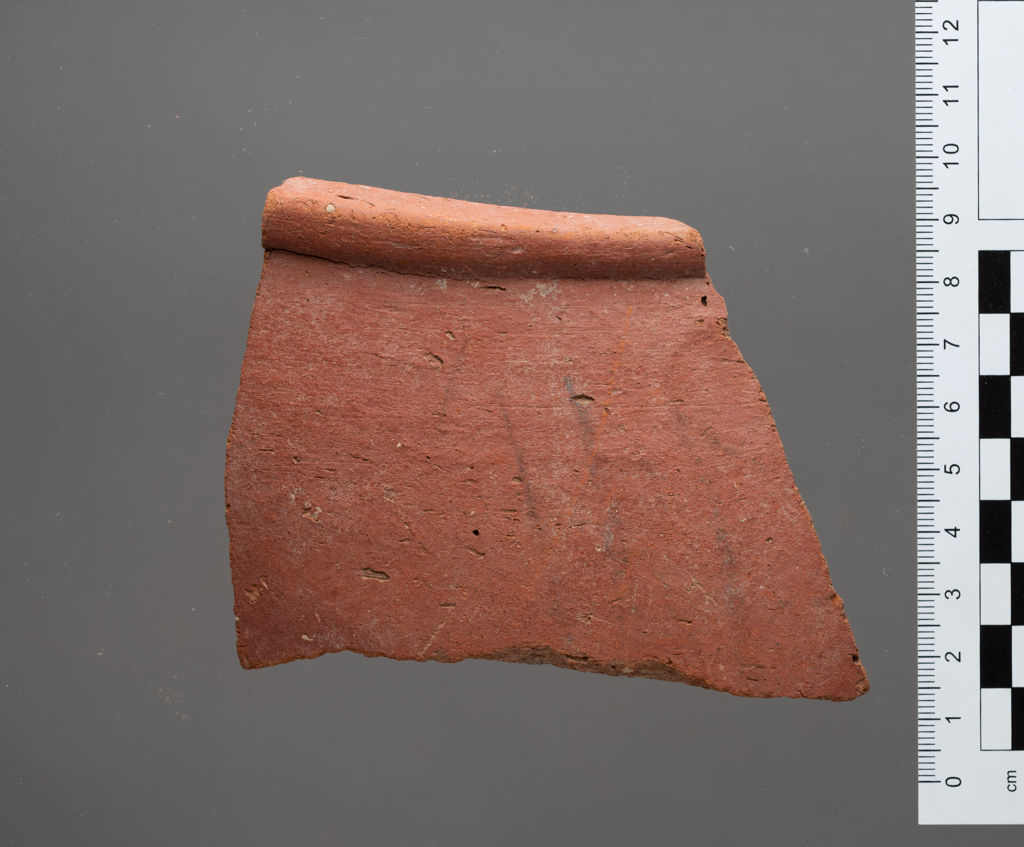
5.1.2 Pot-stands
The examples occur in a very standardised form with a diameter between 13 and 16 cm. They have an everted rim that thickens slightly towards its external edge, a cylindrical wall, and a rounded, externally thickened base. The coarse clay fabric usually has a grey core. The pot-stands show no wear-marks, confirming the hypothesis formulated in the 2018 season that their usage was limited in time, possibly to the embalming procedure and consequent deposition (Figs. 24, 25).
Pot-stand C1192. Photo by Nicola Dell’Aquila/Leiden-Turin Expedition to Saqqara.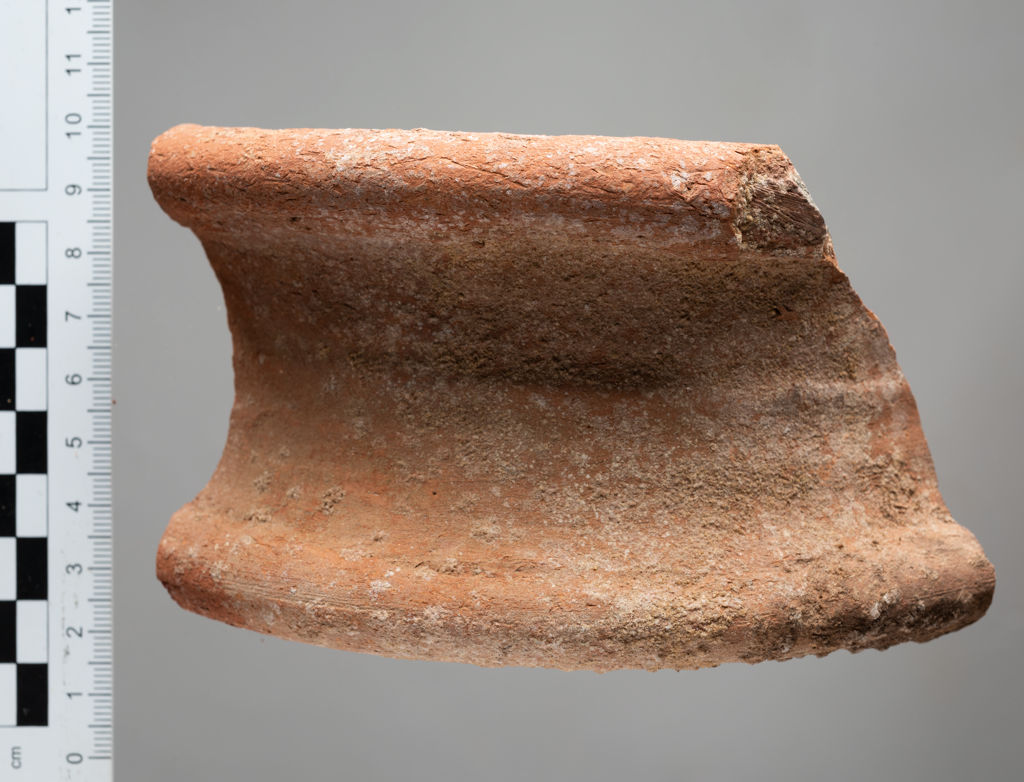
Pot-stand C1194. Photo by Nicola Dell’Aquila/Leiden-Turin Expedition to Saqqara.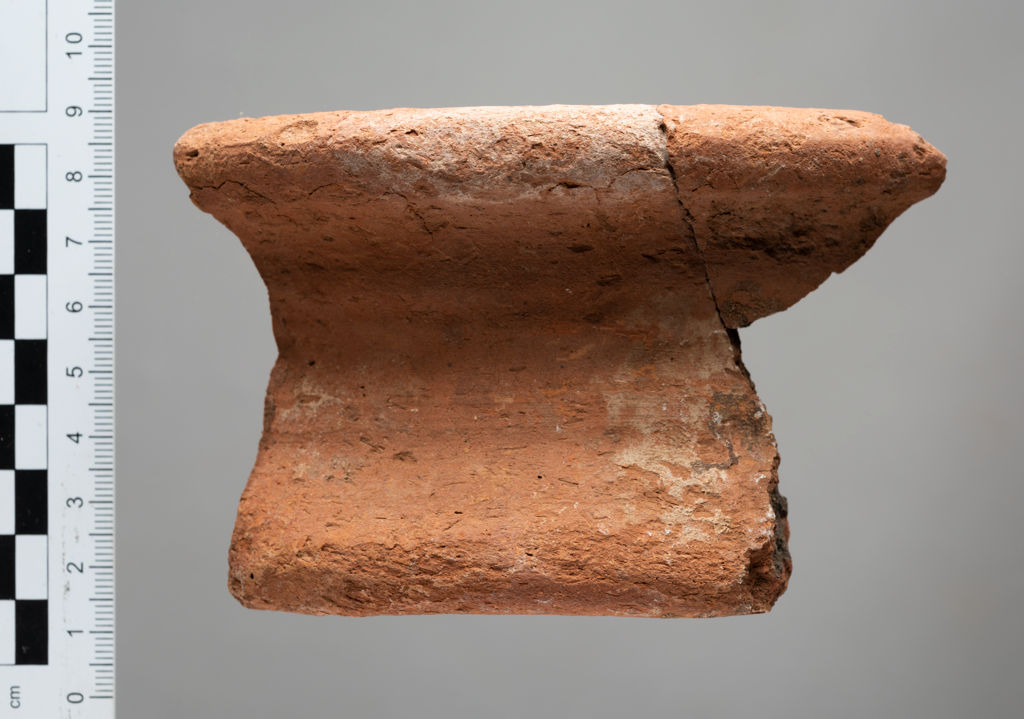
5.1.3 Bottles
Those identified in 2019 are of the same types as those identified in 2018: 68% have a vertical rim, with a shallow indentation just below it, a cylindrical neck, ovoid body, and convex, slightly pointed base (Figs. 26, 27); 21% (Figs. 28, 29) are characterised by two shallow ridges just below the rim; 11% (Fig. 30) have a slightly inturned rim, a short cylindrical neck, an ovoid body, and a rounded base. The first two types have a burnished red slip, while the third is plain. Though all are manufactured from Nile silt,
The “embalmers’ caches” include small percentages of New Kingdom (2%) and Late Antique (6%) materials. The majority (92%) of the pottery from these caches is consistent with a Late Period, fifth century BCE date.
Bottle C1201. Photo by Nicola Dell’Aquila/Leiden-Turin Expedition to Saqqara.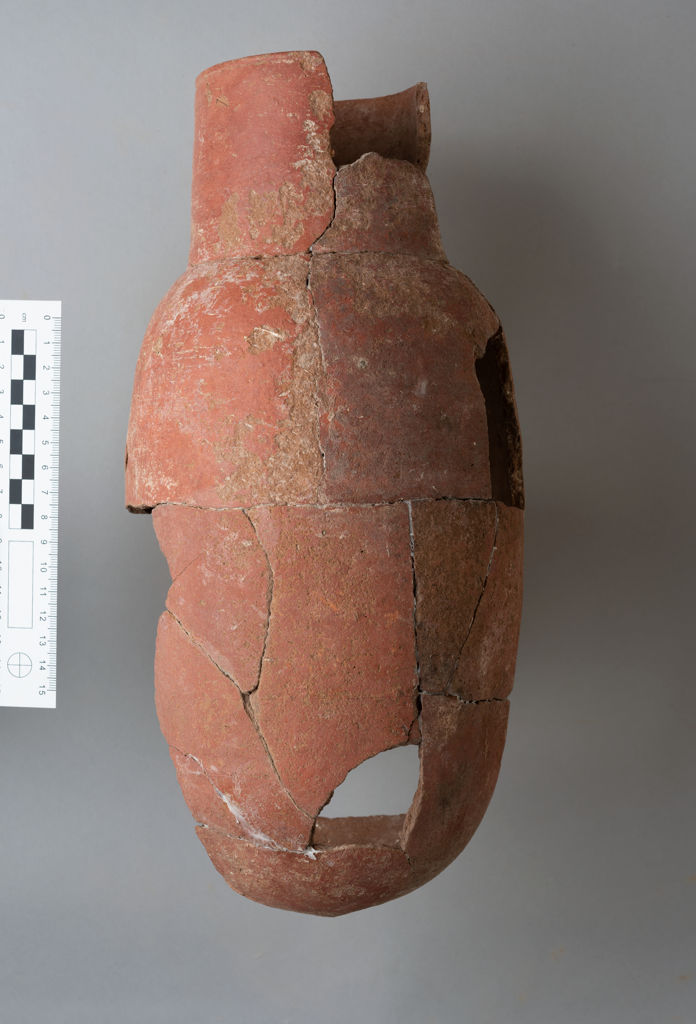
Bottle C1195. Photo by Nicola Dell’Aquila/Leiden-Turin Expedition to Saqqara.
Bottle C1217. Photo by Nicola Dell’Aquila/Leiden-Turin Expedition to Saqqara.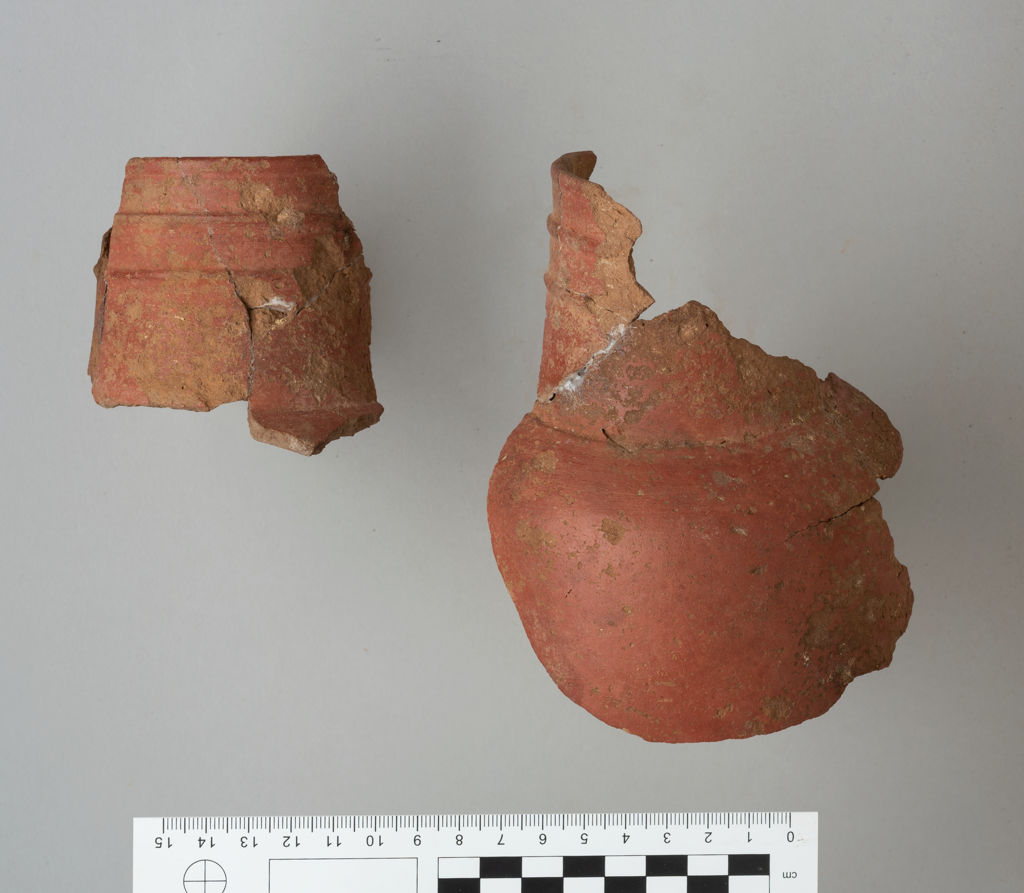
Bottle C1274. Photo by Nicola Dell’Aquila/Leiden-Turin Expedition to Saqqara.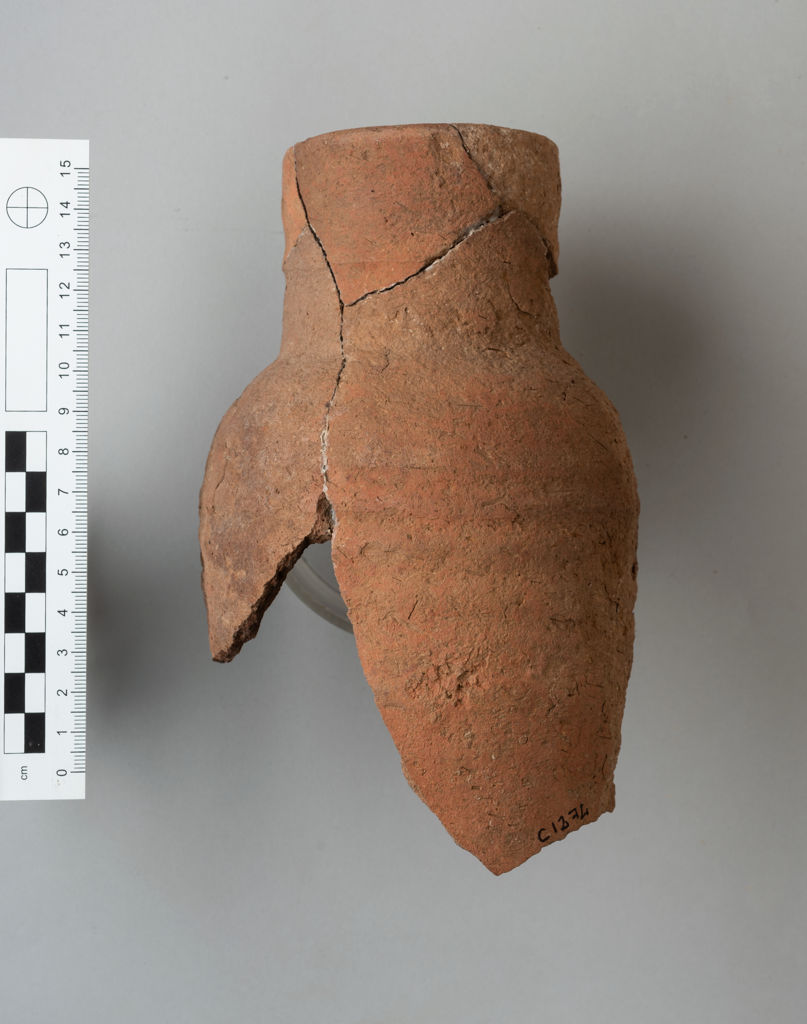
Bottle C1272. Photo by Nicola Dell’Aquila/Leiden-Turin Expedition to Saqqara.
5.2 Shaft 131
The pottery from this location27 displays a very similar typological and chronological profile as the assemblage from the “embalmers’ cache”: “goldfish” bowls, bottles, and pot stands from the Late Period (62%), with occasional (10%) Late Roman/Late Antique amphorae and dishes, and New Kingdom (17%) beer and funnel-necked jars.28 Additionally, four small plates with direct rims, oblique walls, and flat, string-cut bases, also made of J1 Nile silt and dated to the Late Period, were identified.
5.3 The spoil heaps
The vast majority of the pottery processed during the 2019 season was recovered from the spoil heaps. The investigation of the less disturbed, sealed contexts found immediately underneath these heaps was a priority. A rigorous statistical analysis was undertaken for the pottery from the contexts underlying the modern surface and therefore belonging to less jumbled contexts (see below). It included a detailed description of all diagnostic sherds and vessels, taking into account fabric, measurements, percentage of the preserved diameter (either rim or base), style, and surface treatment, including decoration. Parallels with the existing site typology were established. This analytical strategy will facilitate accurate counts of the amount of vessels originally present in each context and high-probability estimates of the minimum number of forms originally deposited in the assemblages. The identification of the type and frequency of vessels will help to
The statistical analysis identified new forms not previously represented in the Saqqara assemblage, increasing the site typology by 157 new diagnostics. These were all registered with C-numbers, and their measurements, fabric, surface treatment, typological parallels, and dating were recorded in detail, with accompanying general analytical and interpretative comments. The vases have been drawn and photographed and will be integrated in the existing site typology from next year onwards. Such a statistical approach is an accurate method for the analysis of ceramics retrieved from secure contexts. For surface finds of pottery and finds from excavation spoil heaps, a general fabric and typological identification was given, along with a general description. Body and diagnostic sherds were counted and registered, and their relative percentages calculated.
The preliminary analysis of these materials confirms the preponderance of Late Period and Late Antique contexts. The Late Antique material mainly consists of Late Roman amphorae (LR1 and LR7), Aswan Ware (mainly open shapes) and locally produced cooking ware. A minor portion of the Late Antique materials consists of large dishes and basins, often with wavy rims, and having a polychrome decoration of geometric or stylised floral motifs, applied to the interior, the exterior, or the lip (see for example Fig. 31).
Basin C1223 decorated with geometric motifs (external and internal surfaces). Photos by Nicola Dell’Aquila/Leiden-Turin Expedition to Saqqara.
Imported pottery appears to have been abundant during the Late Period and in Late Antiquity, confirming the observations made during the previous season. During both periods, the vast majority of imports appear to come from the Eastern Mediterranean. LR1 amphorae are, unsurprisingly, by far the most common type of imported transport containers excavated from the Late Antique layers (9% of the total number of sherds processed; 74% of all imported sherds). Additionally, during the same period there is a noticeable scarcity of imports from North Africa (Tunisia and Libya), as African sigillata occurs in very low percentages. The Late Period shows a prevalence of Greek and Phoenician imports, with a slight prevalence of Torpedo Jars.
Among the LR1 amphorae, three examples with tituli picti (see, for example, Fig. 32) are noteworthy. Tituli picti, written in cursive Greek and preferably with red instead of black ink (as in the case of the Saqqara examples), occur very often on Late Antique transport containers.29 Related to commercial marks and added in extremely stylised writing, these signs are often difficult to read. Several different types of tituli picti may occur on LR1 amphorae.30 They occur on the neck, shoulder, or in the proximity of the handles.
New Kingdom material is only represented by a small number of blue painted sherds, very occasional beer jars, funnel-necked jars, and sherds manufactured from both Marl D and F, indicating a privileged regional import from the Eastern Delta (Marl F), and Lower and Middle Egypt (Marl D). The almost complete absence of Marl A, on the other hand, indicates limited imports from the Theban area and prompts the question of network exchanges between Saqqara and Upper Egypt during the Ramesside period.
LR1 Amphora C1307 with titulus pictus and detail. Photos by Nicola Dell’Aquila/Leiden-Turin Expedition to Saqqara.
6. Preliminary analysis of human remains
(Ali Jelene Scheers)
Differently than in the previous excavation season, the skeletal material recovered during the 2019 season consisted solely of loose surface material that cannot be traced to a complete skeleton. As such, most of the season was spent reorganising and inventorying the skeletal material from previous seasons (see below).
The loose surface material that was studied during the 2019 season consisted of 3121 individual bones. However, due to time constraints not all recovered material could be studied; consequently, the numbers noted here are not a complete representation of everything that was found during the 2019 season. The remaining bones will be studied at the start of the next season.
Of the 3121 individual bones studied, 66 were of animals and 419 were found out of context. This leaves us with 2636 individual human bones that can be ascribed to a well-defined archaeological context. These can be used to determine the MNI (minimum number of individuals) for the area excavated in 2019.
Of the 48 contexts identified during the 2019 season, 31 contained human bone material. Of these, context 332 – a dump mound from earlier excavations – contained the most pieces, with 417 individual bones. Context 322, also a surface deposit from the excavation of nearby tombs, came in second with 242 individual bones. Three other contexts31 contained between 200 and 230 individual bones each. Six contexts32 fall in the 100-to-199-item range, while the remaining contexts33 all contained less
The MNI is determined by examining each of the bone fragments in a given context and estimating how many individuals they represent. Doing this for each context separately is problematic, as commingling and scattering between contexts (and over the whole site in general) has certainly happened through the years. The MNI should thus be calculated for the whole range of individual bones excavated during the 2019 season. This results in a MNI of 26 individuals, based on the presence of 21 adult left 5th metatarsals and 5 sub-adult right femora. As this is only the minimum number of individuals, the true number of individuals scattered throughout the area of this year’s excavation is probably higher, but of course impossible to determine exactly.
7. Objects and reliefs
(Lara Weiss and Daniel Soliman)
As expected, the dumps of earlier excavations yielded many fragmentary objects whose original archaeological context was lost. Yet, a provenance can be proposed for some groups, such as twenty fragments of calcite stoneware, mostly dating to the Early Dynastic period, which probably derive from the Second Dynasty elite tomb underneath the tomb of Maya.35 This tomb, as well as the one underneath the tomb of Meryneith,36 are under investigation by Ilona Regulski.
Over 60 limestone fragments dating to the New Kingdom were recovered, the majority of which were small and non-diagnostic. Many were decorated in relief, some with traces of pigment. Still, it was often not possible to sufficiently interpret their decoration or to understand their provenance, although some may come from the new tomb discovered in 2018 or perhaps even from the tomb of Maya and Merit. A few reliefs, described below, are of particular interest.
Fragment R31 belonged to a fine raised relief. It shows the face of a woman wearing an elaborate wig. It is cut in a style that is similar to that of the decoration of the tomb of Maya, although no join could be established. The fragment may perhaps rather derive from another tomb of a similar date. Two smaller limestone fragments of funerary stelae were found. R68 is the right upper part of a round-topped stela showing Anubis in the shape of a recumbent jackal on a booth. R74 is stylistically datable to the Ramesside period. It shows a seated woman and an inscription that may identify her as a mistress of the house named Meryt.
The largest architectural fragments were found inside or immediately adjacent to the new tomb. One very damaged limestone block, F82, is worked in sunken relief in a style that is characteristic of the late Eighteenth Dynasty and early Nineteenth Dynasty. It is inscribed with titles, one of which is
Block R78. Photo by Nicola Dell’Aquila/Leiden-Turin Expedition to Saqqara.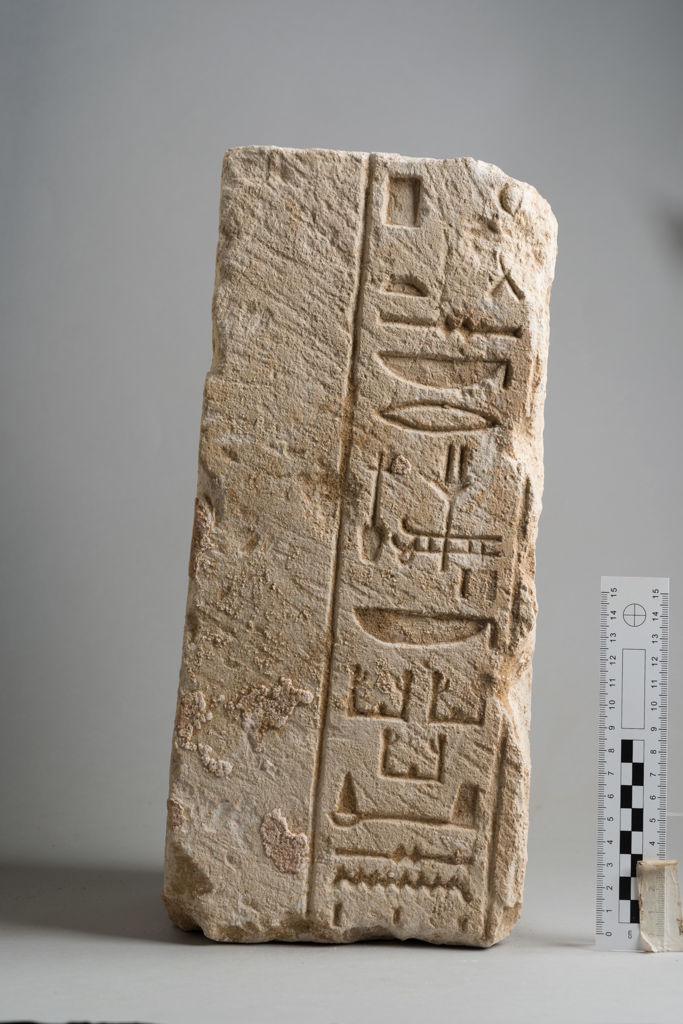
The rectangular capital of a column, R66, is inscribed in sunken relief with an offering formula containing
Various smaller objects also date to the New Kingdom, such as eight very fragile, fragmentary wooden shabtis of the Ramesside period, which were restored by Islam Taha. Unfortunately, their inscriptions are still largely illegible. The fragments of a delicate cosmetic jar, F389, and a brightly painted fragment of a wooden shabti box, F186, showing the arms of the deceased in adoration, should date from the same period (Fig. 34). The latter is inscribed with the male name Iuty, which is attested in Memphis in the Eighteenth Dynasty.39 It is also tempting to link this fragment to the statue, now in Leiden, of the Nineteenth Dynasty physician Iuty, whose name is written in the exact same way.40 A female candidate is the woman by the same name attested on a stela dedicated by an Amenmose, probably from Saqqara.41 All other attestations of the name Iuty date to the Eighteenth Dynasty.42 Two curious calcite objects attributed to the Ramesside period, F192 and F378 (Figs. 35, 36), have been tentatively identified as elements of the wheels of a chariot. Parallels excavated in Egypt43 and from museum collections44 suggest that at least F192 is probably a yoke-saddle finial.45
F186. Photo by Nicola Dell’Aquila/Leiden-Turin Expedition to Saqqara.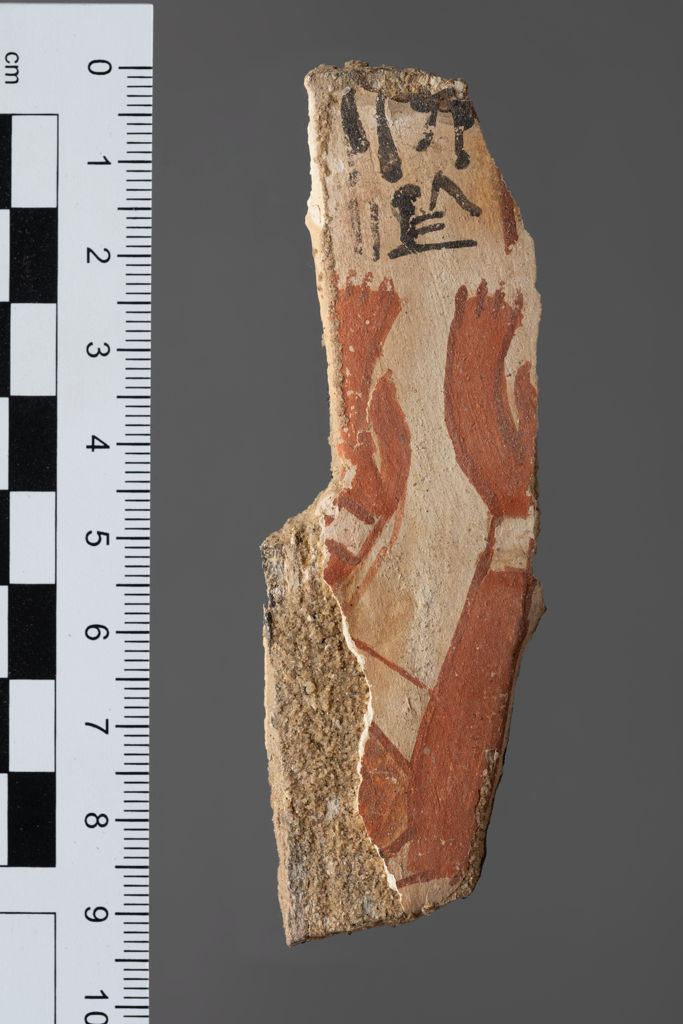
F192. Photo by Nicola Dell’Aquila/Leiden-Turin Expedition to Saqqara.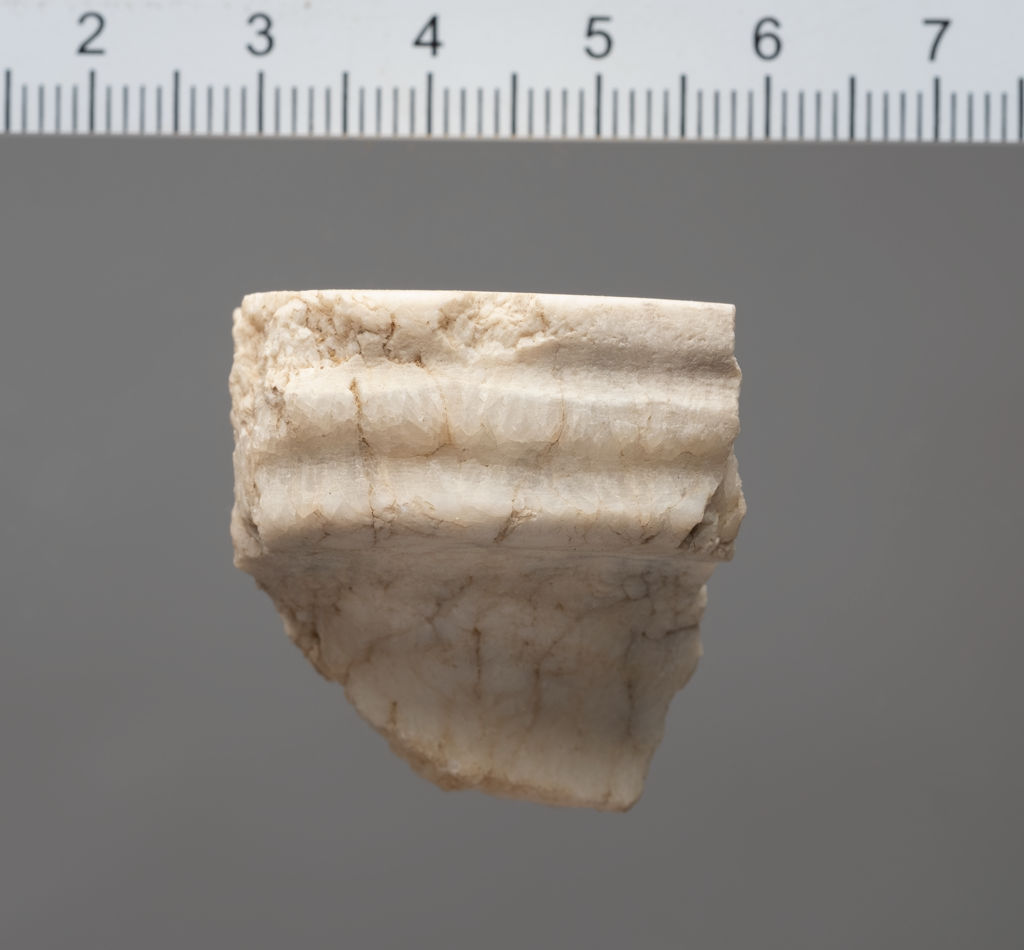
F378. Photo by Nicola Dell’Aquila/Leiden-Turin Expedition to Saqqara.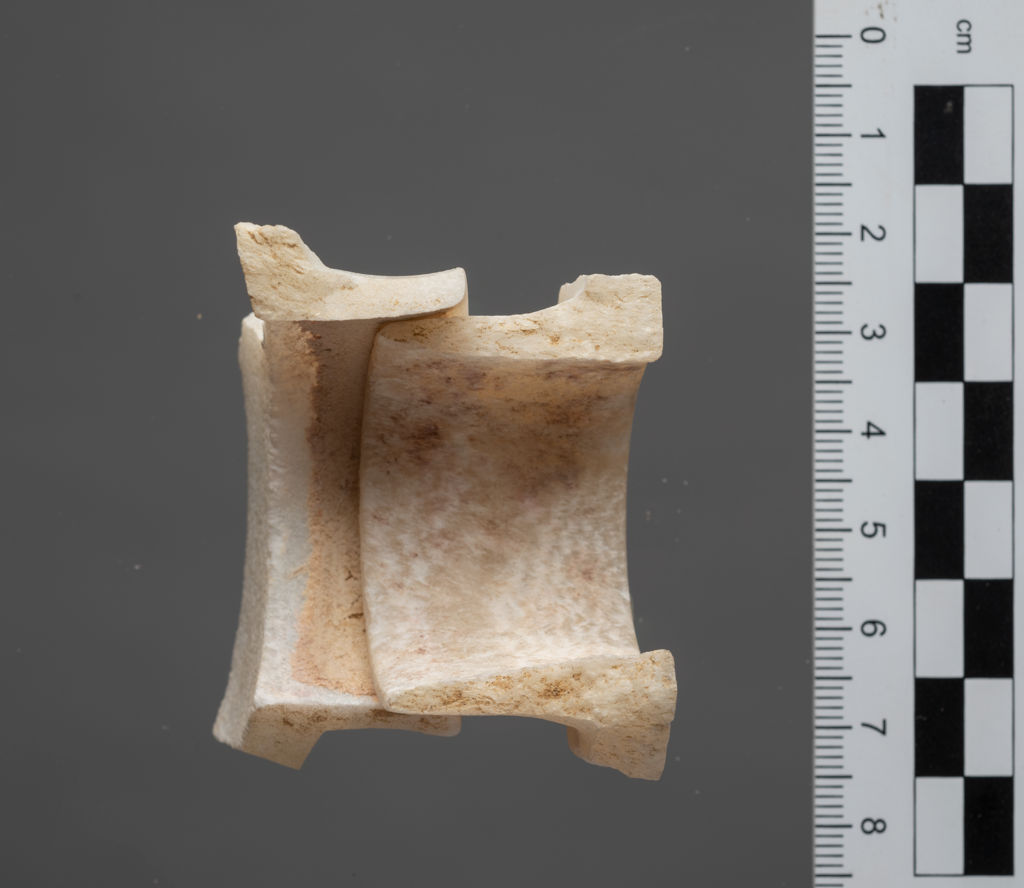
Ten shabti fragments date to the Third Intermediate Period. Substantial quantities of fragments of textile, rope, and matting, as well as wood and reed were recovered. This material likely originates from
Two fragments of inscribed papyrus were discovered among the material from the spoil heaps. One fragment, F95, was restored and consolidated by the Head of Restoration at Saqqara, Ashraf Ashour Shaaban. After restoration, the now legible passages suggested it contains a Coptic letter written in black ink.46 The text, which is very fragmentary, mentions the month Pamenoth. The second papyrus fragment, F283, was folded when found, and may constitute the lower edge of a Book of the Dead papyrus, decorated with two red bands framed by thin black lines. Traces of columns with black hieroglyphs are visible, but too little is preserved to identify the content of the text. A similar fragment, dated to the New Kingdom, was found in the tomb of Horemheb.47
Excavations also recovered a group of tools made of reused pottery. This category of objects consists of recut ceramic sherds, and includes 12 rounded specimens and 22 scrapers.48 The scrapers were probably used for the production of ceramics as well as the processing of wood, stone, fur, and skins.49 The rounded pieces are relatively common, but their exact date and function remain subject to debate:50 they have been interpreted as tokens, lids, or game pieces. The interpretation of the objects as lids can probably be dismissed in the absence of a comparable number of receptacles with matching-shaped mouths.51 Objects made of reused pottery have hitherto mostly been found in production areas.52 The group found this season may also come from an occupation layer excavated in 2018 that showed signs of production activity.53 The finds from this season, a flint stone knife blade (F351), a whetstone (F337), a possible biface (F400), and a few ceramic bowl fragments used as painters’ palettes (one for plaster) are comparable to those from last season. These tools are difficult to date but, based on the archaeological context as well as the fabric, a Late Period date is perhaps the most plausible.
8. A Late Period offering table
(Huw Twiston Davis and Daniel Soliman)
One half of a double-sided offering table from the Late Period, F92 (Fig. 37), was found in context 320.
F92. Photo by Nicola Dell’Aquila/Leiden-Turin Expedition to Saqqara.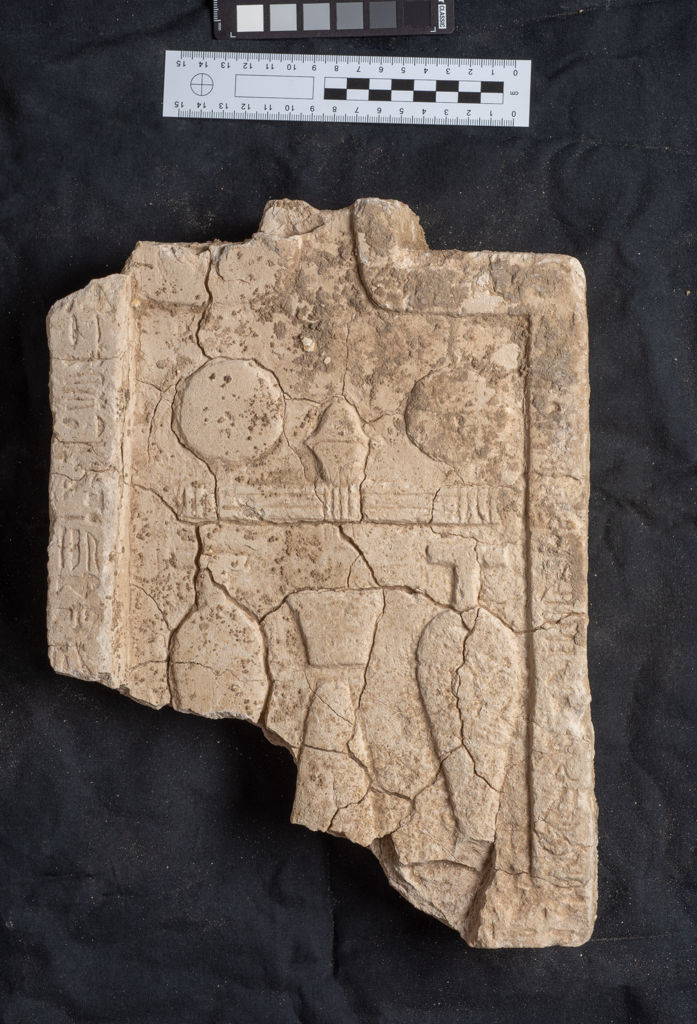
9. Reorganisation of storage rooms
(Lara Weiss, Daniel Soliman, Alice Salvador, and Ali Jelene Scheers)
A reorganisation of the on-site storerooms was undertaken to make better use of the existing space and create additional storage space in order to preserve excavated materials as best as possible and make them more readily accessible in the future. With kind support from architect Nicholas Warner, new timber shelving was installed in the north storage vault and the first subterranean chamber of the tomb shaft of Horemheb, and in two chapels. Material excavated in previous seasons was repacked where necessary to be stored more efficiently. Specifically, Horemheb B was inventoried, and broken crates were replaced. The materials of seasons 2002, 2003, 2004, 2009, 2010 and 2013, and the materials from shaft 99/I, Maya, the Tia deposit and Ramose were moved to gallery M in the subterranean complex of Horemheb. The materials stored in the subterranean complex of Meryneith were re-crated and inventoried as well. The new pottery materials have been stored on new wooden shelves, guaranteeing easier access to, and an improved preservation of, the whole assemblage.
10. Tomb conservation
(Nicholas Warner)
In this season, conservation work at the site was carried out between 18 March and 20 April. Following the serious damage to mud-brick structures caused by heavy rainfall in the winter of 2018-2019, the focus of the work was on remedial conservation of the worst affected tombs, most particularly the tomb of Horemheb. The mud-brick entrance pylon of the tomb of Horemheb, previously consolidated in February 2010, was badly affected by rains over subsequent years. Severely eroded sections of brickwork were cut out and replaced, and all wall faces were re-pointed with mud mortar. The upper surfaces of each pylon block were given a plastic isolation layer below the upper two courses of brickwork, and a layer of stone chips was used to strengthen the top layer of mud render above. This render contained a small percentage (1 part to 10 parts of water) of Addibond adhesive, a non-migratory plasticiser. It is hoped that this will improve the adhesion and wear of the plaster over time, but the treatment will be monitored to evaluate its success, both at this location and in other areas where it was employed this season. The two storeroom roofs between the second and third courtyards of the tomb were consolidated with new mud-bricks over a plastic isolation sheet. The new brickwork was stepped in order to reduce the load on the vaults below, and a layer of stone chips and pottery sherds was used to strengthen the top layer of mud render above the consolidated brickwork. This render also contained a small percentage of Addibond plasticiser. The original inner
In addition to the conservation work in the tomb of Horemheb, work was carried out elsewhere in the necropolis. At the small chapel of Paser, wind and rain erosion had damaged its west and north walls, consolidated over a decade ago, to the point where a structural collapse was feared. The base of the west wall and the entire north wall of this chapel were therefore faced with limestone rubble set in lime mortar. The roofs of Maya’s chapels were also re-plastered to inhibit rainwater infiltration. At the tomb of Meryneith, it was found that the concrete plank covering the shaft of the tomb was causing severe condensation. The plank was therefore replaced with a new painted steel open grille cover to increase air circulation in the subterranean chambers.
Bibliography
Aston, Barbara G., “The Pottery”, in Maarten J. Raven, Vincent Verschoor, Marije Vugts, and René van Walsem, The Memphite Tomb of Horemheb Commander in Chief of Tutankhamun, V: The Forecourt and the Area South of the Tomb with Some Notes on the Tomb of Tia (PALMA 6), Turnhout 2011, pp. 191–303.
Aston, David A. and Barbara G. Aston, Late Period Pottery from the New Kingdom Necropolis at Saqqâra: Egypt Exploration Society, National Museum of Antiquities, Leiden, Excavations 1975-1995 (EES ExcMem 92), London 2010.
Aubert, Jacques F. and Liliane Aubert, Statuettes funéraires égyptiennes du département des Monnaies, Médailles et Antiques, Paris 2005.
Berendsen, William B., Principaux monuments du Musée Égyptien de Florence, Premiere partie: Steles, bas-reliefs et fresques, Paris 1882.
Del Vesco, Paolo, Christian Greco, Miriam Müller, Nico Staring, and Lara Weiss, “Current Research of the Leiden-Turin Archaeological Mission in Saqqara. A Preliminary Report on the 2018 Season”, RiME 3 (2019), pp. 22–46; http://dx.doi.org/10.29353/rime.2019.2236
Fournet, Jean-Luc and Dominique Pieri, “Les dipinti amphoriques d’Antinoopolis”, in Pintaudi, Rosario, Antinoupolis I: scavi e materiali, Firenze 2008, pp. 175–216.
Frood, Elizabeth and Kate Howley, “Applications of Reflectance Transformation Imaging (RTI) in the Study of Temple Graffiti”, in Elena Pischikova, Julia Budka, and Kenneth Griffin (eds.), Thebes in the First Millennium BC, Newcastle upon Tyne 2014, pp. 625–38.
Gasperini, Valentina and Alice Salvador, “Preliminary Report on the Pottery from the 2018 Excavation”, in Paolo Del Vesco, Christian Greco, Miriam Müller, Nico Staring, and Lara Weiss, “Current Research of the Leiden-Turin Archaeological Mission in Saqqara. A Preliminary Report on the 2018 Season”, RiME 3 (2019), pp. 35–38; doi.org/10.29353/rime.2019.2236.
Herold, Anja, Streitwagentechnologie in der Ramses–Stadt: Knäufe, Knöpfe und Scheiben aus Stein (Forschungen in der Ramses–Stadt, Die Grabungen des Pelizaeus-Museums Hildesheim in Qantir – Pi-Ramesse 5), Mainz 2006.
Herzberg, Anne, “Individuelle Identitäten und Kollektive Biographien einer Residenzstadt des Neuen Reiches“, Zeitschrift für Ägyptische Sprache und Altertumskunde, Beihefte (forthcoming).
Kamal, Ahmed B., Tables d’offrandes I. Catalogue général des antiquités égyptiennes du Musée du Caire No 23001–23256, Cairo 1909.
Kleinitz, Cornelia, “Reflectance Transformation Imaging (RTI) in der Bestandsdokumentation der Sekundärbilder und -inschriften von Musawwarat as Sufra im Rahmen des Musawwarat Graffiti Project”, Der Antike Sudan. Mitteilungen der Sudanarchäologischen Gesellschaft zu Berlin 23 (2012), pp. 7–20.
Lacher-Raschdorff, Claudia M., Das Grab des Königs Ninetjer in Saqqara: architektonische Entwicklung frühzeitlicher Grabanlagen in Ägypten, Wiesbaden 2014.
Leitz, Christian, Lexikon der ägyptischen Götter und Götterbezeichnungen, III, Leuven 2002–2003.
Leitz, Christian, Lexikon der ägyptischen Götter und Götterbezeichnungen, IV, Leuven 2002–2003.
Lehmann, Manuela, “Die materielle Kultur der Spät- und Ptolemäerzeit im Delta Ägyptens am Beispiel von Tell el-Dab’a” (PhD dissertation, Freie Universität Berlin), Berlin 2018.
Lepsius, Richard K., Denkmäler aus Aegypten und Aethiopien nach den Zeichnungen der von Seiner Majestät dem Könige von Preussen, Friedrich Wilhelm IV, nach diesen Ländern gesendeten und in den Jahren 1842–1845 ausgeführten wissenschaftlichen Expedition, Leipzig 1897.
Lüddeckens, Erich, Wilhelm Brunsch, Hans-Jörg Thissen, Günter Vittmann, and Karl-Theodor Zauzich, Demotisches Namenbuch, I, Wiesbaden 1980–2000.
Martin, Geoffrey T., “Excavations at the Memphite Tomb of Ḥoremḥeb, 1975: Preliminary Report”, JEA 62 (1976), pp. 5–13.
Martin, Geoffrey T., Corpus of Reliefs of the New Kingdom from the Memphite Necropolis and Lower Egypt, I, London 1987.
Martin, Geoffrey T., “The Saqqâra New Kingdom Necropolis Excavations, 1986: Preliminary Report”, JEA 73 (1987), pp. 1–9.
Martin, Geoffrey T., The Memphite Tomb of Horemheb, Commander-in-Chief of Tut’ankhamūn, I: The Reliefs, Inscriptions, and Commentary (EES ExcMem 55), London 1989.
Martin, Geoffrey T., The Tomb of Maya and Meryt, I: The Reliefs, Inscriptions, and Commentary (EES ExcMem 99), London 2012.
Martin, Geoffrey T., Maarten J. Raven, Barbara G. Aston, and Jacobus Van Dijk, “The Tomb of Maya and Meryt: Preliminary Report on the Saqqâra Excavations, 1987–8”, JEA 74 (1988), pp. 1–14.
Martin, Geoffrey T. and Hans Schneider, The Memphite Tomb of Ḥoremḥeb: Commander-in-chief of Tut‘ankhamūn, II: A Catalogue of the Finds (EES ExcMem 60), Louvain 1996.
Ouzman, Sven, “Seeing is Deceiving: Rock Art and the Non-Visual”, WorldArch 33/2 (2001), pp. 237–56.
Perfetti, Luca, Carlo Polari, and Francesco Fassi, “Fisheye Photogrammetry: Tests and Methodologies for the Survey of Narrow Spaces”, Int. Arch. Photogramm. Remote Sens. Spatial Inf. Sci., XLII–2/W3 (2017), pp. 573–80; doi.org/10.5194/isprs-archives-XLII-2-W3-573-2017.
Perfetti, Luca, Francesco Fassi and Corinna Rossi, “Fisheye Photogrammetry to Generate Low–Cost DTMs”, Int. Arch. Photogramm. Remote Sens. Spatial Inf. Sci. (2019), pp. 257–63; doi.org/10.5194/isprs-archives-XLII-2-W17-257-2019.
Raedler, Christine, “Keramikschaber aus den Werkstätten der Ramses–Stadt”, in: Edgar B. Pusch and Manfred Bietak (eds.), Die Keramik des Grabungsplatzes Q I – Teil 2, Schaber – Marken – Scherben (Forschungen in der Ramses–Stadt: die Grabungen des Pelizaeus-Museums Hildesheim in Qantir – Pi-Ramesse 5), Hildesheim 2007, pp. 11–266.
Ranke, Hermann,
Raven, Maarten J., The Tomb of Maya and Meryt II. Objects and Skeletal Remains (EES ExcMem 65), Louvain 2001.
Raven, Maarten J., René van Walsem, Barbara G. Aston, and Eugen Strouhal, “Preliminary report on the Leiden Excavations at Saqqara, Season 2002: The Tomb of Meryneith”, JEOL 37 (2001–2002), pp. 91–109.
Raven, Maarten J., René van Walsem, Barbara G. Aston, Amanda Dunsmore, and Ladislava Horáčková, “Preliminary Report on the Leiden Excavations at Saqqara, Season 2003: The Tomb of Meryneith”, JEOL 38 (2003–2004), pp. 5–23.
Raven, Maarten J. and Wybren K. Taconis, Egyptian Mummies. Radiological Atlas of the Collections in the National Museum of Antiquities at Leiden, Turnhout 2005.
Raven, Maarten J., Barbara Aston, Ladislava Horáčková, and Geoffrey T. Martin, “Preliminary Report on the Leiden Excavations at Saqqara, Season 2005: The Tombs of Horemheb and Meryneith”, JEOL 39 (2005), pp. 5–17.
Raven, Maarten J., Barbara G. Aston, Ladislava Horáčková, Daniela Picchi, and Annelies Bleeker, “Preliminary Report on the Leiden Excavations at Saqqara, Season 2013: The Tombs of Sethnakht and an Anonymous Official”, JEOL 44 (2012-2013), pp. 3–21.
Raven, Maarten J. and René van Walsem, The Tomb of Meryneith at Saqqara. (PALMA 10), Turnhout 2014.
Regulski, Ilona, “Investigating a New Dynasty 2 Necropolis at South Saqqara”, BMSAES 13 (2009), pp. 221–37; https://www.britishmuseum.org/pdf/Regulski2009_b.pdf
Regulski, Ilona, Kim Duistermaat and Claudia Lacher, “A New Second Dynasty Tomb”, in Maarten J. Raven, Harold M. Hays, Claudia Lacher, Kim Duistermaat, Ilona Regulski, Barbara G. Aston, Ladislava Horáčková, and Nicholas Warner, “Preliminary Report on the Leiden Excavations at Saqqara: Season 2008, The Tomb of Ptahemwia”, JEOL 41 (2009), pp. 17–20.
Rossi, Corinna, “Immaterial Data and Material Culture: Surveying and Modelling the New Kingdom Necropolis of Saqqara”, Saqqara Newsletter 17 (2019), pp. 61-71.
Schiaparelli, Ernesto, Museo Archeologico di Firenze: Antichità egizie, Rome 1887.
Schneider, Hans, The Memphite Tomb of Ḥoremḥeb: Commander-in-Chief of Tut‘ankhamūn. Vol. II: A Catalogue of the Finds (EES ExcMem 60), Louvain 1996.
Schneider, Hans and Maarten J. Raven, De Egyptische Oudheid, Den Haag 1981.
Staring, Nico, “Products of the Physical Engagement with Sacred Space: The New Kingdom Non–Textual Tomb–Graffiti at Saqqara”, in: Ben J.J. Haring, Kyra V.J. Van der Moezel, and Daniel M. Soliman (eds.), Decoding Signs of Identity. Egyptian Workmen’s Marks in Archaeological, Historical, Comparative and Theoretical Perspective. Proceedings of a Conference in Leiden, 13–15 December 2013 (EU 32), Leiden/Leuven 2018, pp. 79–112.
Staring, Nico and Paul W. van Pelt, “Interpreting Graffiti in the Saqqara New Kingdom Necropolis as Expressions of Popular Customs and Beliefs”, RiME 3 (2019), pp. 120–68; http://dx.doi.org/10.29353/rime.2019.2577.
Urcia, Alberto and Antonio Curci, “Digital Documentation and Three–dimensional Reconstruction of Predynastic–Early Dynastic Rock Art in Aswan (Egypt)”, in Matthew Douglas D. Adams (ed.), Egypt at Its Origins 4: Proceedings of the Fourth International Conference “Origin of the State. Predynastic and Early Dynastic Egypt”, New York, 26th–30th July 2011 (OLA 252), Leuven 2016, pp. 411–26.
Urcia, Alberto, John C. Darnell, Colleen M. Darnell, and Sara E. Zaia, “From Plastic Sheets to Tablet PCs: A Digital Epigraphic Method for Recording Egyptian Rock Art and Inscriptions”, African Archaeological Review 35/2 (2018), pp. 169–89.
Notes
- The 2019 season was made possible by the participation of: Mohamed Abdel Tawab Fawzy, Assam Rashed, Abbas Moussa, Rafat Kis, Sami Ashour, Mohamed el Aseli, Adel Mohamed Othman, Guda Abd el Khaled, Saber Hussein, Mohamed Abd el Zayr, Emad Bayoumi, Mohamed Ramadan el Hady, Abd el Mohsen Ali, Emad Abd el Minan, Mohamed Hamed, Salama Ramadan Fekri, Mahdy Abd el Nabi, Mohamed Ibrahim Shahed, Sameh Rageb Farag, Mohamed Samir Hassan, Mahmoud Samir Hassan, Said Imam, Karam Gomaa Abdel Razek, Gomaa Salama Gomaa, Gamal Abdel Gamaal el Eswed, Gamal Kilani, Assam Saad, Assam Mundy Afrah, Eid Said Imam Salem, Fahmy Ahmed Mohamed, Abu el Hassan Ahmed, Walid Sayed, Faris Sayed, Mohsen Awad, Ahmed Gamal, Hagag Ibrahim, Ibrahim Naser, Hussein Abdul, Sadiq Ahmed, Abd el Rahman Samir, Tareq Guda, Mahmoud Abu Sareya, Yahya Rabia Nefs, Abd el Tawab Shaeeb, Nabil Adawy, Assam Azmy Ali, Gaballa Abu el Ghayeb, Islam Gamal Abd el Alam, Mohamed Gerwesh, Ahmed Sami Azem, Omar Abd el Gawab, Ahmed Mohamed Fekri, Fahmy Mohamed Shaaban, and Taha Mohamed Hany.↑
- The project “The Walking Dead at Saqqara. The Making of a Cultural Geography” received a grant from NWO (dossier no. 016.Vidi.174.032) and is hosted at Leiden University, Institute for Area Studies (LIAS). It runs from 1 November 2017 to 30 October 2022, see <a href="https://www.nwo.nl/onderzoek-en-resultaten/onderzoeksprojecten/i/ 52/28952.html">https://www.nwo.nl/onderzoek-en-resultaten/onderzoeksprojecten/i/ 52/28952.html</a>.↑
- The tomb numbering indicates the grid square in which the tomb or tomb entrance is located, in this case V82, followed by sequential numbers distinguishing tombs found in the same square.↑
- Martin et al., <i>JEA</i> 74 (1988), pp. 1–14, esp. p. 6 ff.↑
- Martin et al., <i>JEA</i> 73 (1987), pp. 1–9.↑
- Personal communication by Barbara Aston.↑
- See the previous report, Del Vesco et al., <i>RiME</i> 3 (2019), <a href="http://dx.doi.org/10.29353/rime.2019.2236">http://dx.doi.org/10.29353/rime.2019.2236</a>.↑
- Lepsius, <i>Denkmäler</i> (1897), p. 182.↑
- Del Vesco et al., <i>RiME</i> 3 (2019), <a href="http://dx.doi.org/10.29353/rime.2019.2236">http://dx.doi.org/10.29353/rime.2019.2236</a>.↑
- Rossi, <i>Saqqara Newsletter</i> 17 (2019), pp. 61-71.↑
- Perfetti et al., <i>Int. Arch. Photogramm. Remote Sens. Spatial Inf. Sci.</i> (2019).↑
- Perfetti et al., <i>Int. Arch. Photogramm. Remote Sens. Spatial Inf. Sci.</i> XLII–2/W3 (2017).↑
- Del Vesco et al., <i>RiME</i> 3 (2019), pp. 12–13, <a href="https://rivista.museoegizio.it/article/current-research-of-the-leiden-turin-archaeological-mission-in-saqqara-a-preliminary-report-on-the-2018-season/">https://rivista.museoegizio.it/article/current-research-of-the-leiden-turin-archaeological-mission-in-saqqara-a-preliminary-report-on-the-2018-season/</a>.↑
- L. Perfetti’s PhD research is partly funded by the European Research Council Consolidator Grant no. 681673, under the European Union’s Horizon 2020 research and innovation program. Thanks are due to his supervisor, Prof. F. Fassi, for his constant support and advice.↑
- Martin, <i>JEA</i> 62 (1976), pp. 5–13; Martin, <i>The Memphite Tomb of Horemheb</i>, 1989.↑
- Raven et al., <i>JEOL</i> 38 (2003–2004), pp. 15–16; Raven et al., <i>JEOL</i> 39 (2005), pp. 6–10; Raven and Van Walsem, <i>The Memphite Tomb of Horemheb</i>, V, 2011, pp. 27–35.↑
- Martin, <i>The Memphite Tomb of Horemheb</i>, 1989, pp. 157–59, pls. 146–49.↑
- Raven and Van Walsem, <i>The Memphite Tomb of Horemheb</i>, V, 2011, pp. 29–30, fig. I.8 (nos. 35–44).↑
- Raven et al., <i>JEOL</i> 44 (2012–2013), p. 21. See also Staring and Van Pelt, <i>RiME</i> 3 (2019), passim, <a href="http://dx.doi.org/10.29353/rime.2019.2577">http://dx.doi.org/10.29353/rime.2019.2577</a>.↑
- Urcia and Curci, in Adams (ed.), <i>Egypt at Its Origins 4</i>, 2016, pp. 411–26; Frood and Howley, in Pischikova et al. (eds.), <i>Thebes in the First Millennium BC</i>, pp. 625–38; Kleinitz, <i>Der Antike Sudan</i> 23 (2012), pp. 7–20.↑
- Compare for example the digital epigraphy methods used for the documentation of rock art: Urcia et al., <i>AAR</i> 35/2 (2018), pp. 169–89.↑
- Raven also considers the possibility that the forecourt was built in the early Ramesside period: Raven and Van Walsem, <i>The Memphite Tomb of Horemheb</i>, V, 2011, p. 28.↑
- Staring, in Haring et al. (eds.), <i>Decoding Signs of Identity</i>, pp. 103–11. Cf. Ouzman, <i>WA</i> 33/2 (2001), pp. 237–56.↑
- Aston, in Raven and Van Walsem, <i>The Memphite Tomb of Horemheb</i>, V, 2011, p. 226.↑
- See Gasperini and Salvador, <i>RiME</i> 3 (2019), pp. 14–17, <a href="http://dx.doi.org/10.29353/rime.2019.2236">http://dx.doi.org/10.29353/rime.2019.2236</a>. See also Aston and Aston, <i>Late Period Pottery</i>, 2010, for other “embalmers’ caches” previously excavated at the site.↑
- See Gasperini and Salvador, <i>RiME</i> 3 (2019), p. 15, <a href="http://dx.doi.org/10.29353/rime.2019.2236">http://dx.doi.org/10.29353/rime.2019.2236</a>, with previous bibliography.↑
- See Del Vesco et al., <i>RiME</i> 3 (2019), pp. 12–13, <a href="https://rivista.museoegizio.it/article/current-research-of-the-leiden-turin-archaeological-mission-in-saqqara-a-preliminary-report-on-the-2018-season/">https://rivista.museoegizio.it/article/current-research-of-the-leiden-turin-archaeological-mission-in-saqqara-a-preliminary-report-on-the-2018-season/</a>.↑
- The remaining 11% of sherds processed consists of Old Kingdom pottery (Meidum bowls, 4%) and sherds of uncertain date (7%).↑
- For <i>tituli picti</i> on Late Antique amphorae, see Fournet-Pieri, <i>Antinoupolis</i> I, 2008, pp. 175–78, and p. 184.↑
- See Fournet-Pieri, <i>Antinoupolis</i> I, 2008, pp. 184–203.↑
- Contexts 333, 353, and 340.↑
- Contexts 331, 328, 339, 360, 348, and 324.↑
- Contexts 366, 320, 345, 346, 335, 321, 349, 351, 355, 341, 327, 334, 362, 361, 359, 336, 105, 352, 323, and 445.↑
- Contexts 362, 361, 359, 336, 105, 352, 323, and 445.↑
- Compare, for example, Regulski, <i>BMSAES</i> 13 (2009), pp. 221-37, <a href="https://www.britishmuseum.org/pdf/Regulski2009_b.pdf">https://www.britishmuseum.org/pdf/Regulski2009_b.pdf</a> and Regulski et al., in Raven et al., <i>JEOL</i> 41 (2009), pp. 17-20. On Saqqara in the Second Dynasty cf. e.g. Lacher-Raschdorff, <i>Das Grab des Königs Ninetjer</i>, 2014, p. 49.↑
- Raven et al., <i>JEOL</i> 37 (2001–2002), pp. 91–109.↑
- For this epithet for Nefertem, see Leitz, <i>Lexikon</i>, III, 2002-2003, p. 762.↑
- Martin, <i>The Tomb of Maya and Merit I</i>, 2012, p. 55, no. 12, pl. 64. A comparable piece from Saqqara is a New Kingdom block from the fill beneath the main temple in the animal cemetery, see Martin, <i>Corpus of Reliefs</i>, I, 1987, p. 23, pl. 16, no. 48.↑
- See Ranke, <i>Die ägyptischen Personennamen</i>, I, 1935, p. 18.↑
- Rijksmuseum van Oudheden Leiden, inv. no. AST 10, see Schneider and Raven, <i>De Egyptische Oudheid</i>, 1981, no. 87. That Iuty had a tomb in Saqqara is also suggested, for example, by a relief now in Florence (inv. no. 2605), see Berendsen, <i>Principaux monuments</i>, 1882, pp. 98–99, and Schiaparelli, <i>Museo Archeologico di Firenze</i>, 1887, pp. 333–37.↑
- Kunsthistorisches Museum Wien inv. no. 124, see <a href="http://www.khm.at/de/object/a1e938ce3e/">http://www.khm.at/de/object/a1e938ce3e/</a> and Herzberg, <i>Prosopographia Memphitica</i>, ID 1500. We are indebted to Anne Herzberg for kindly checking for us the database she is creating, for which see <a href="https://www.topoi.org/project/c-1-x-10">https://www.topoi.org/project/c-1-x-10</a>.↑
- Herzberg, <i>Prosopographia Memphitica</i>.↑
- Herold, <i>Streitwagentechnologie in der Ramses-Stadt</i>, 2006, pp. 132–51.↑
- Manchester Museum acc. no. 9659, see <a href="https://egyptmanchester.wordpress.com/2012/08/14/object-biography-9-an-inscribed-harness-finial-from-a-chariot-acc-no-9659/">https://egyptmanchester.wordpress.com/2012/08/14/object-biography-9-an-inscribed-harness-finial-from-a-chariot-acc-no-9659/</a>. Thanks to Campbell Price for providing this reference.↑
- The identification of a second, similar piece is subject to further investigation. We would like to thank Renaud Pietri for his kind feedback on our study of the objects and for sharing additional references.↑
- We are much indebted to Renate Dekker for this information.↑
- Schneider, <i>The Memphite Tomb of Ḥoremḥeb</i>, II, 1996, p. 9, pl. 1, no. 2.↑
- On tools made of pottery, see recently Lehmann, “Die materielle Kultur“, 2018, pp. 658–61. We are indebted to Manuela Lehmann for sharing her work with us. The thesis is currently being prepared for publication in the Tell el-Dab’a Publications series of the Austrian Institute for Oriental and European Archaeology.↑
- Lehmann, “Die materielle Kultur“, 2018, p. 660 with reference to Raedler, in Pusch (ed.), <i>Die Keramik des Grabungsplatzes Q I</i>, 2007, pp. 11–266.↑
- Lehmann, “Die materielle Kultur“, 2018, p. 659.↑
- Lehmann, “Die materielle Kultur“, 2018, p. 659. We are perplexed by Lehmann’s remark that for an interpretation as game pieces the number of attested pieces is too large.↑
- Parallels are known, for example, from Qantir, Tell el-Retaba, Tania, Kom Firin and Amarna, see Lehmann, “Die materielle Kultur“, 2018, p. 660.↑
- Del Vesco et al., <i>RiME</i> 3 (2019), pp. 5-9.↑
- SAK 2002-107, found in shaft 2002/7, see Raven and van Walsem, <i>The tomb of Meryneith at Saqqara</i>, 2014, pp. 236–37, no. 59.↑
- It was provisionally read as the priestly title <named-content content-type="traslitterazione">wr-a</named-content>, “great one of the carrying chair”, predominantly attested during the Old Kingdom (<i>Wb</i>, I, p. 327, no. 20), but also attested on a shabti of Nesbanebdjed, dated to the Thirtieth Dynasty, see Aubert and Aubert, <i>Statuettes funéraires égyptiennes</i>, 2005, pp. 144–45.↑
- See Lüddeckens et al., <i>Demotisches Namenbuch</i>, I, 1980-2000, pp. 228–29.↑
- <i>Wb</i>, III, 156–57.↑
- Rijksmuseum van Oudheden inv. no. L.XII.1-c, see Raven and Taconis, <i>Egyptian Mummies</i>, 2005, pp. 91–94.↑
- Ranke, <i>Die ägyptischen Personennamen</i>, I, p. 217, no. 19.↑
- Ranke, <i>Die ägyptischen Personennamen</i>, I, p. 247, no. 22.↑
- For parallels, see e.g. Kamal, <i>Tables d’offrandes I</i>, 1909, p. 31 (CG 23039), p. 85 (CG 23099) and p. 93 (CG 23112).↑








